In this post I thought I would pull together my ‘adventures’ with making my own tents/shelters over the years. My experience has evolved from utilising simple tarps/ponchos as shelters to creating a variety of tent ‘prototypes’ in Tyvek often followed by a lighter silnylon model (which I then take up the bush to try out).
I have learned a lot in the DIY process which I highly recommend to you. It will save you lots of money and (finally) result in a better shelter than you would otherwise own from a camping store. It is also very likely to be lighter and more functional, as well as being easier to put up and harder to fall down!
First of all let me once again repeat that (after lack of air – definitely to be avoided), the thing which will kill you quickest is ‘exposure’. For example, cold water strips heat away from you 20 x quicker than dry air. You can be gone in a couple of hours. I have experienced it! You need a roof.
NB: Each heading is a link. For some reason I have a glitch which is making all the headings different. Sorry.
The Importance of a Roof
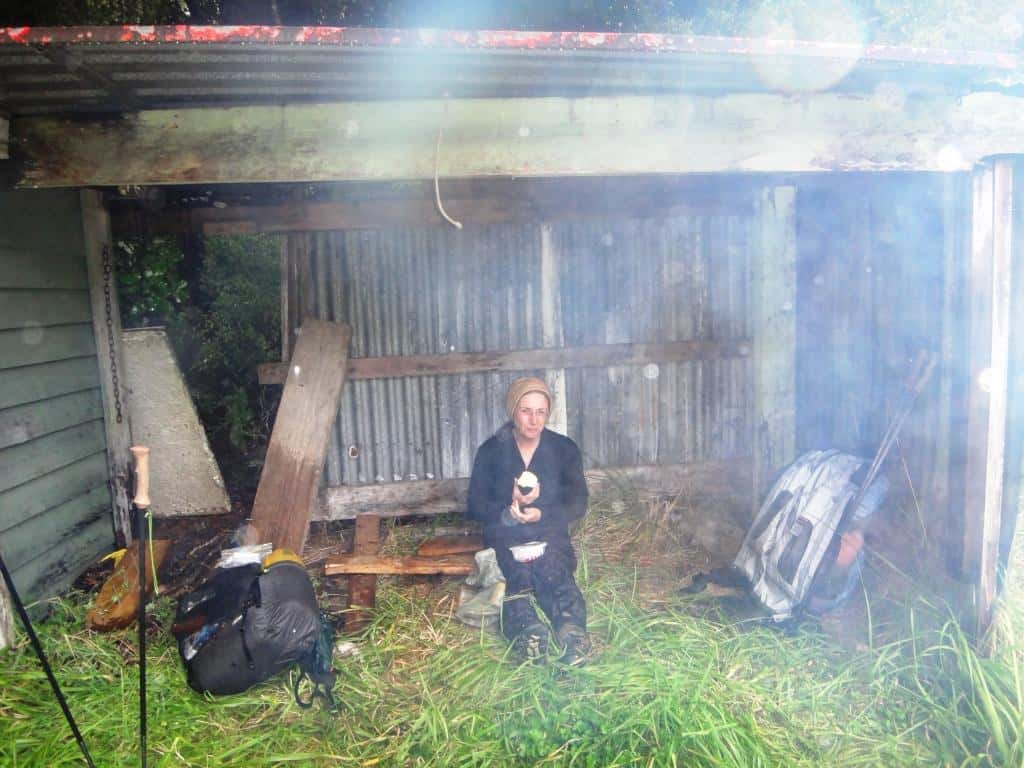
If you have no other shelter and it is wet and cold, you need an air gap above you so you can dry out and the rain does not rob you of all your body heat. This idea may just save your life.
Raincoat Shelter
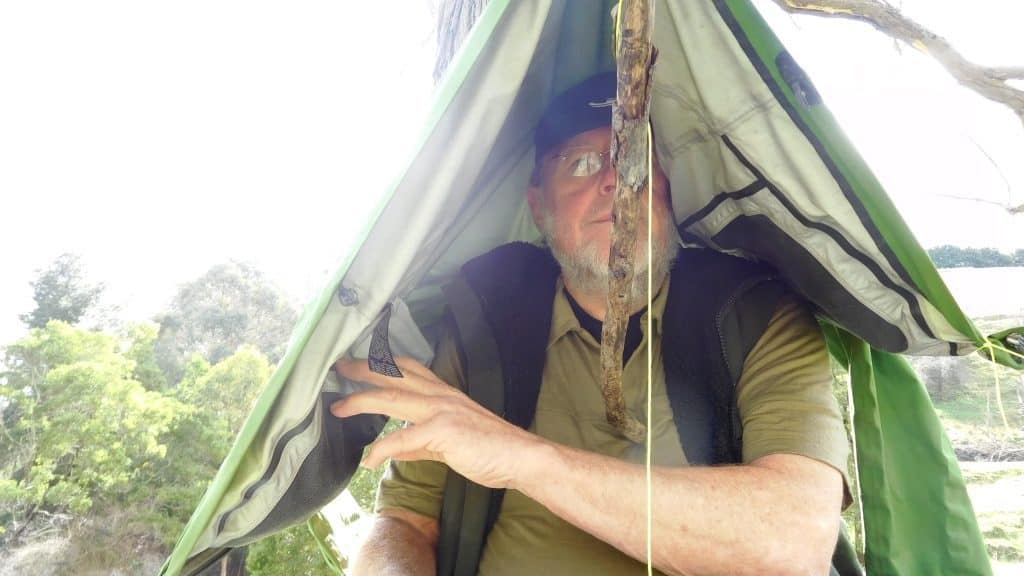
Your small dog also needs a raincoat sometimes:
Tyvek Jack Russell (Rain) Coat: 13 grams!
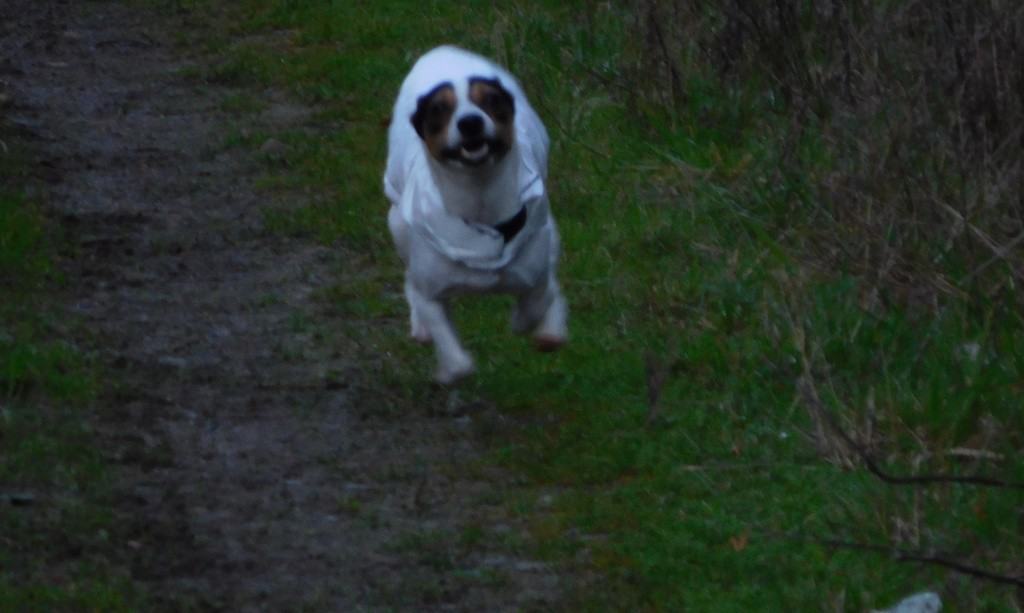
BTW This is how you should carry your raincoat:
The Raincoat Swag – and other mods
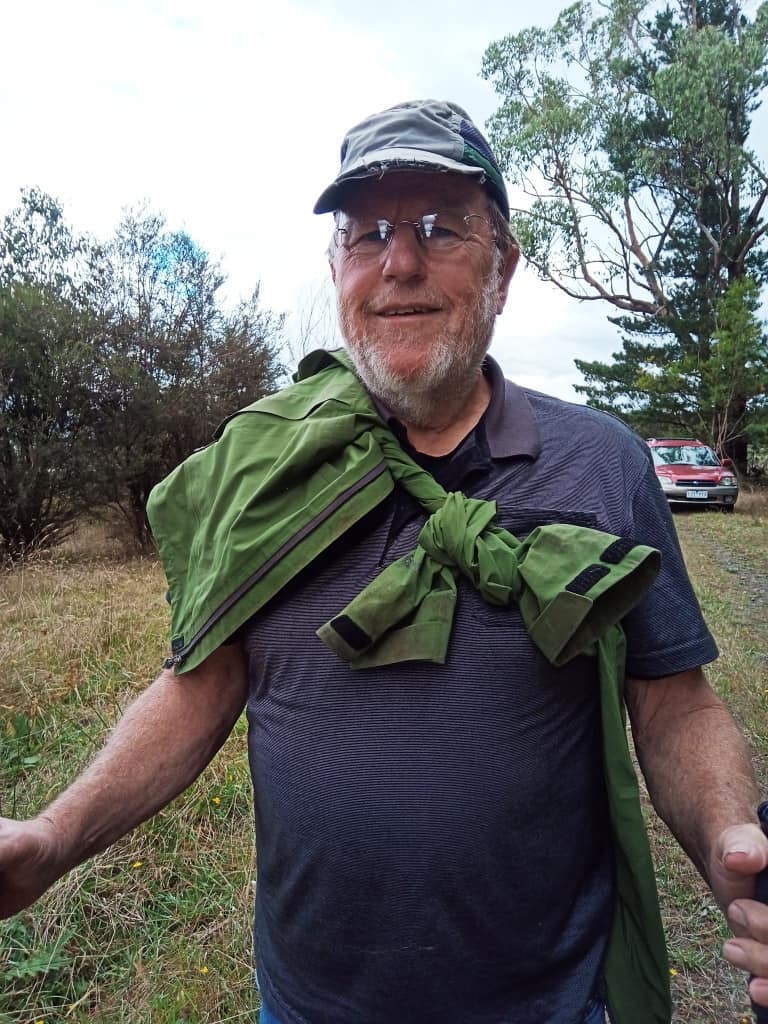
You will always end up with rips and holes in your gear. This is the best stuff I have found to fix them. eg I have repaired a badly ripped Thermarest X-Light pad with it, and the repair is still good after five years.
Cuben Tape
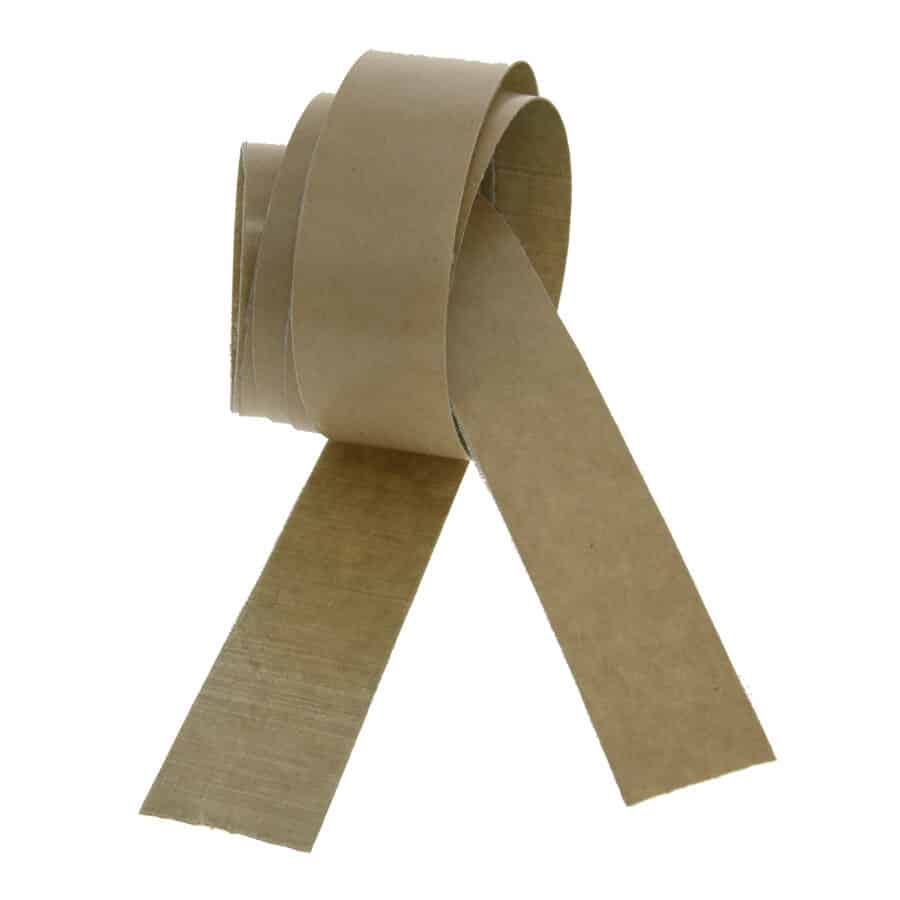
Shelter doesn’t have to cost a lot or weigh very much at all:
20 Gram Raincoat
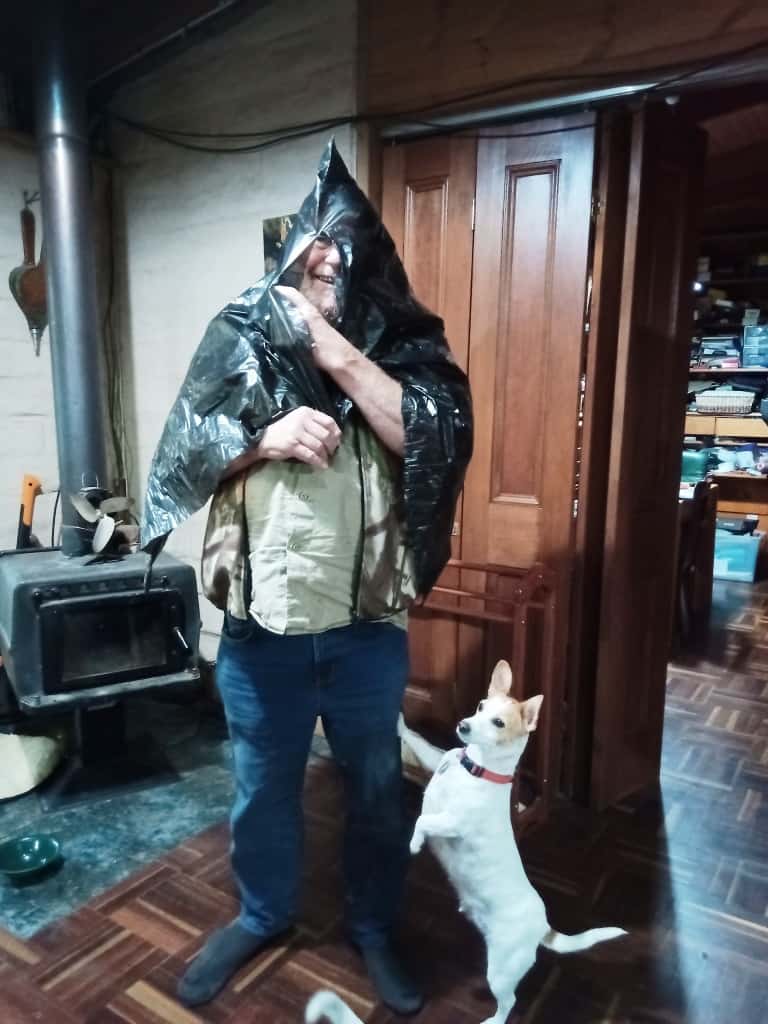
It is always a good idea to check out your shelter before you head into the wilds.
Steve Intent
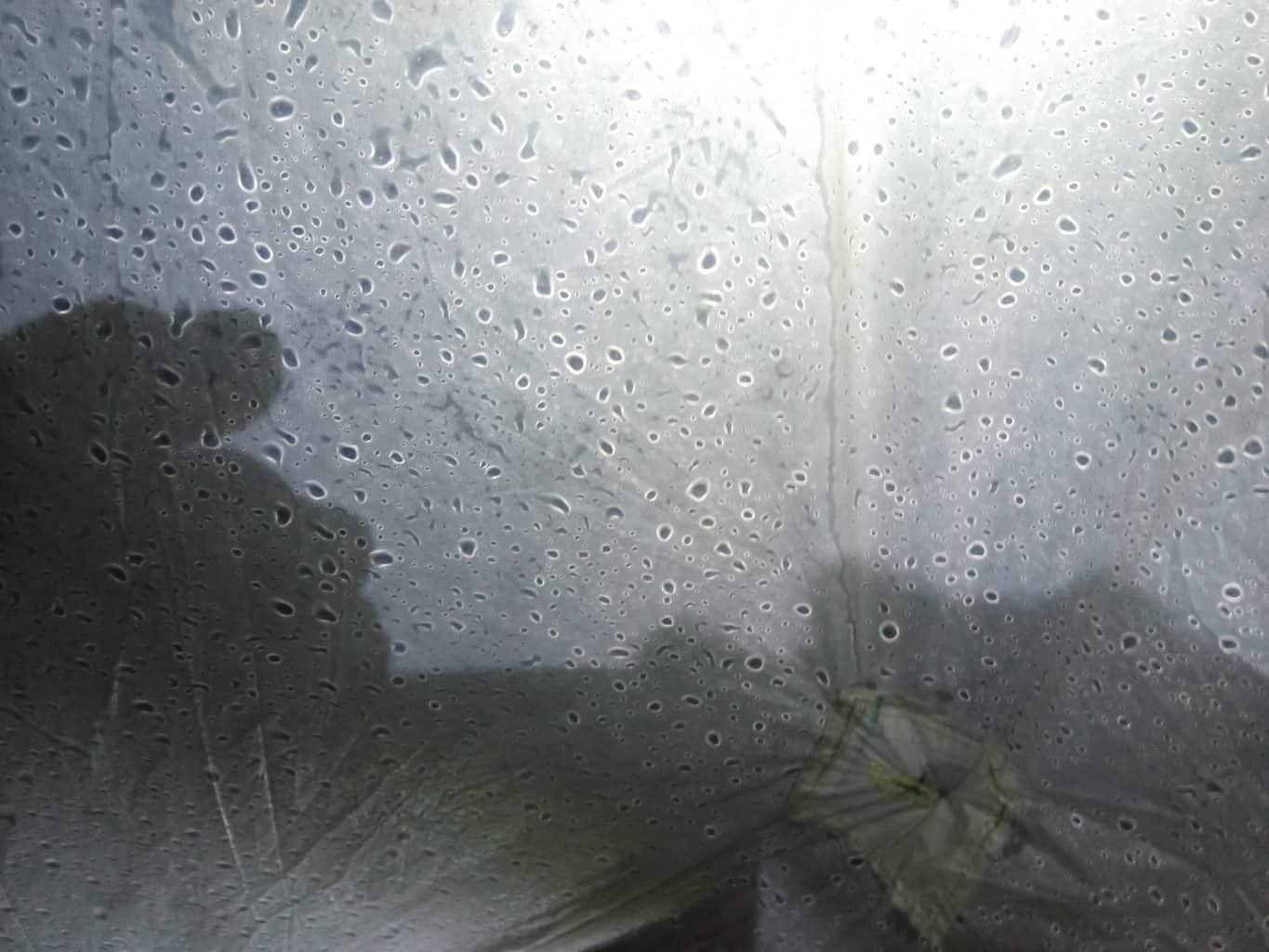
It is also a good idea to have more than one form of shelter. That tent can blow away – as happened to Cherry Gallard at the South Pole! Yet he survived. You can use your raincoat (as above) but a space blanket or one of these is a good idea:
If you could only carry two things in the bush, what would they be?
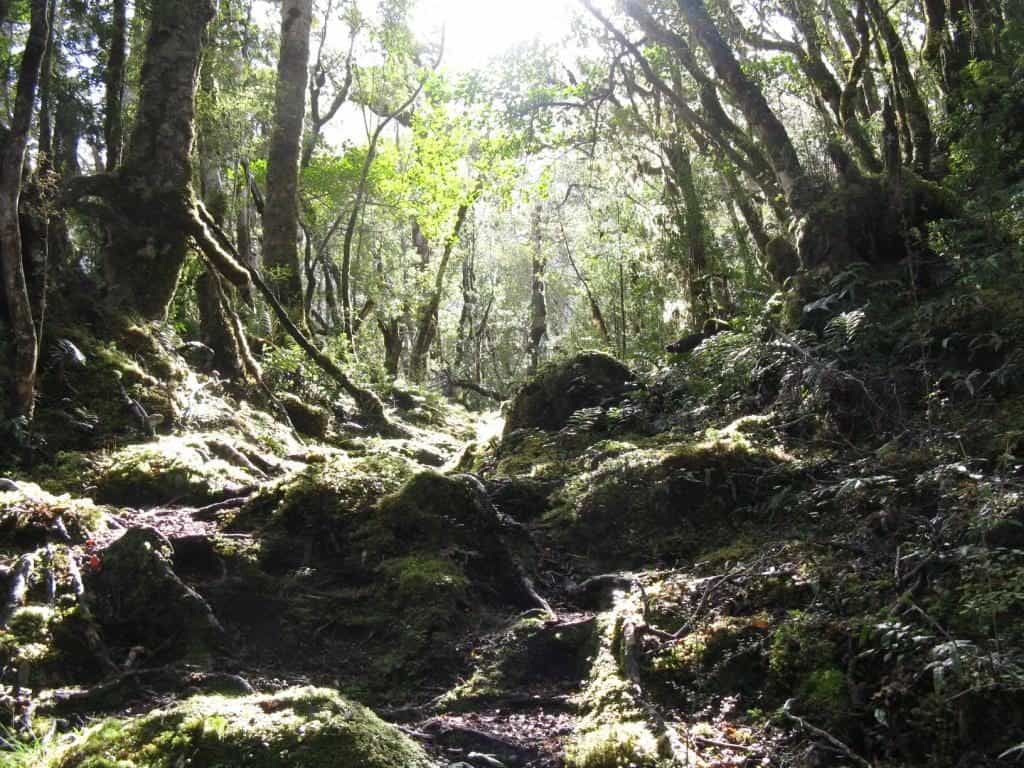
How to avoid being wet & cold while camping
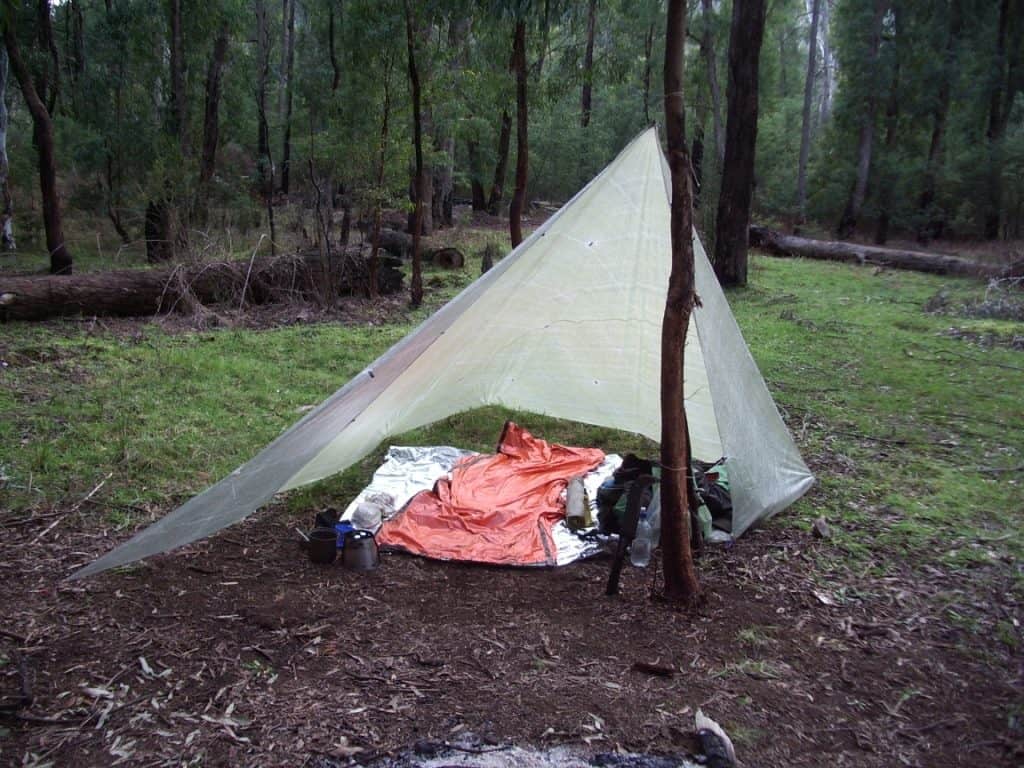
However you can enjoy the rain – and there is one of my early tarps:
How to have Fun When Hiking in the Rain
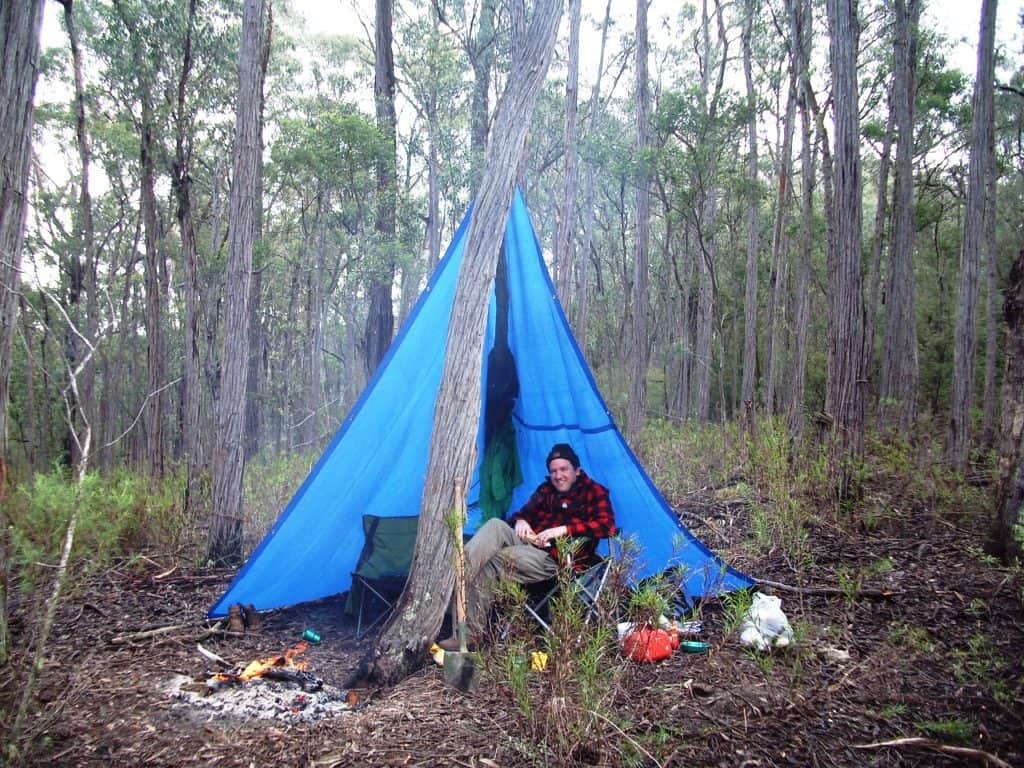
And again:
More Fun in the Rain
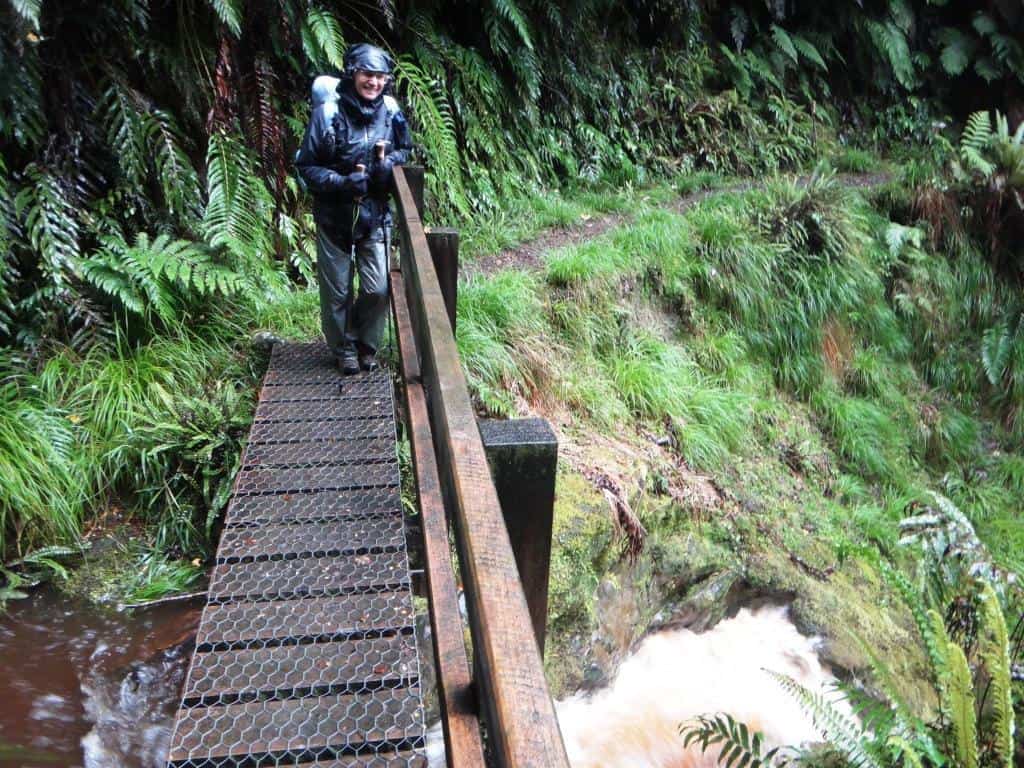
New to DIY tents? You should try this. I hope it convinces you that this is a good way to go instead of handing very large sums of money for products which (often) don’t even do a very good job:
Poly Tent by The Ultralight Hiker on the Cheap
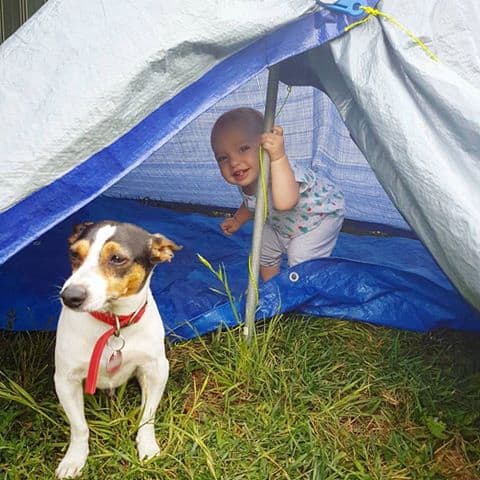
Tyvek: As I said, I use this material for my prototypes because it is realtively cheap at 1pprox $200 a 30 x 3 metre roll. I rder a roll from Home Hardware. It is easy to work with and can be taped (with Tyvek Tape). You can often make the whole tent out of one piece needing only a hem and some tie-outs. I reinforce these with a couple of other pieces of tyvek.
You can use tape as well if you wish. I think Alpacka Australia sell it. I use gross-grain ribbon for tie-outs. You will see (in some of my photos) how I do this now. It has been an evolving process.
Tyvek is moderately fore retardant. I have had no problems with lighting a fire out front. You have t touch a naked flame to it before it melts. Sparks from the fire just roll off it. It also reflects the heat back on you as you sit/stand in the shelter making it very cosy indeed. It has a low propensity to steam up inside. I put he printed side in so that the outside has a nice cheery uniform white colour – easy to see when you are making your way back to camp after a day’s hunting or etc.
Tyvek
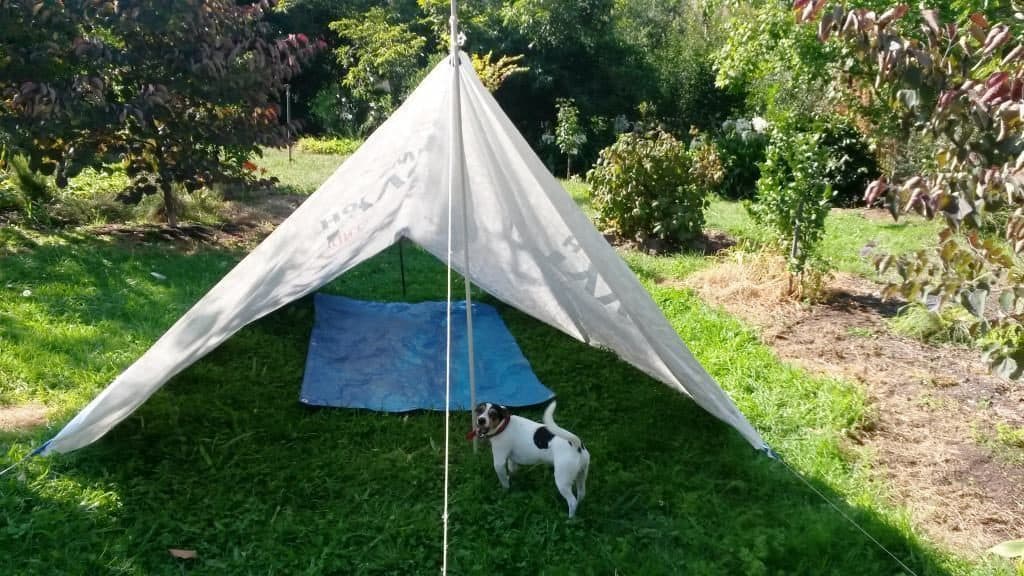
Tyvek Tent Designs
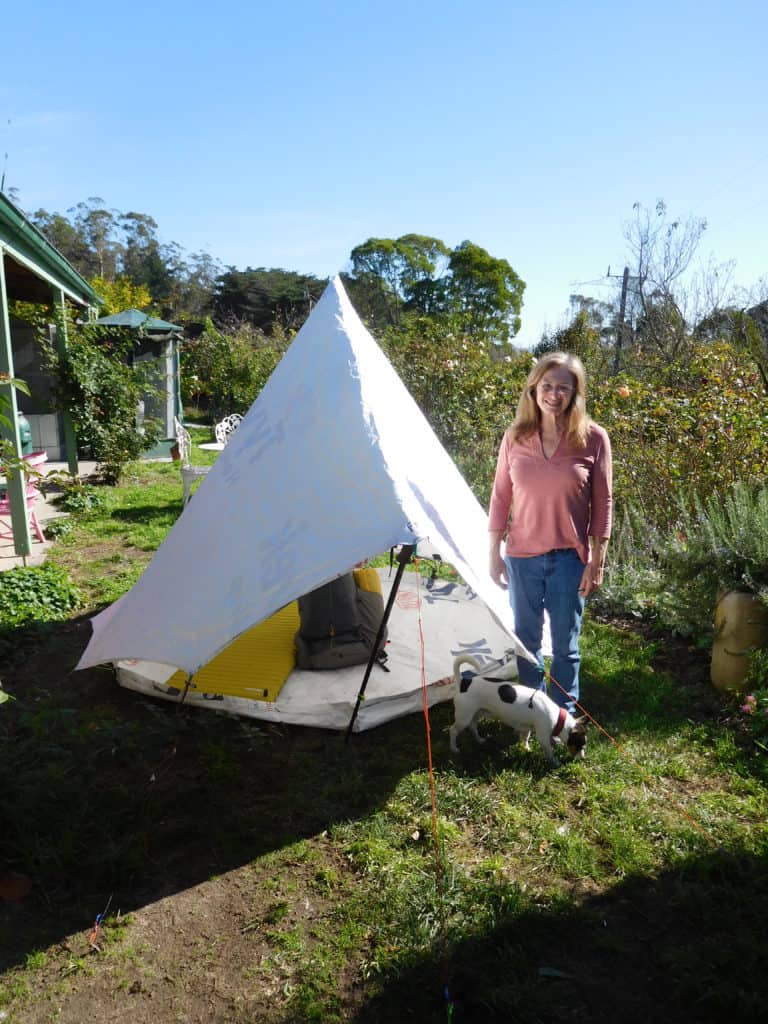
One of the things I learned early on was the importance of catenary curves – and how to make them. I am still using that same template I made years ago.:
Catenary Curves
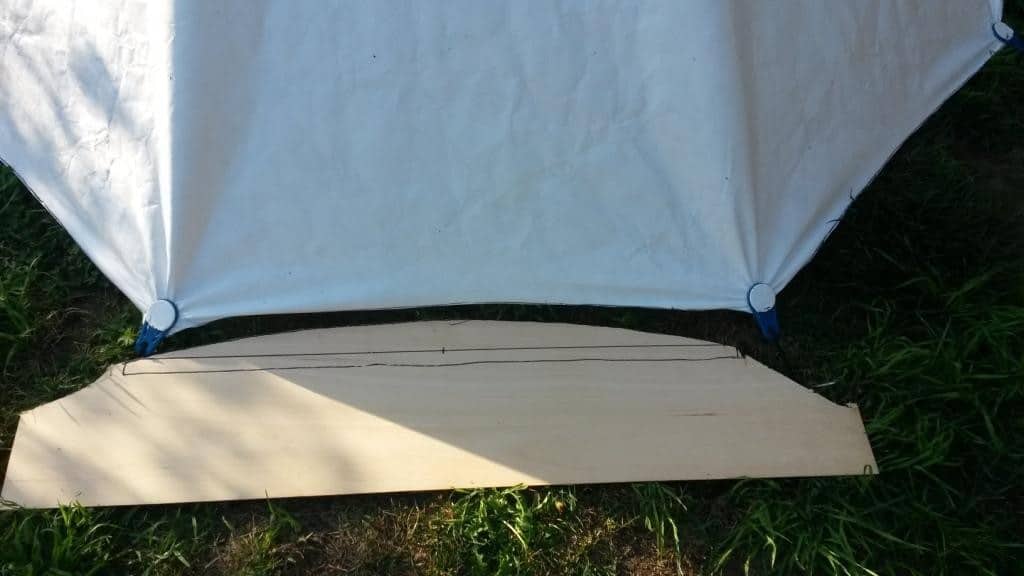
I also worked out an easier kind of
Flat-Felled Seam Alternative
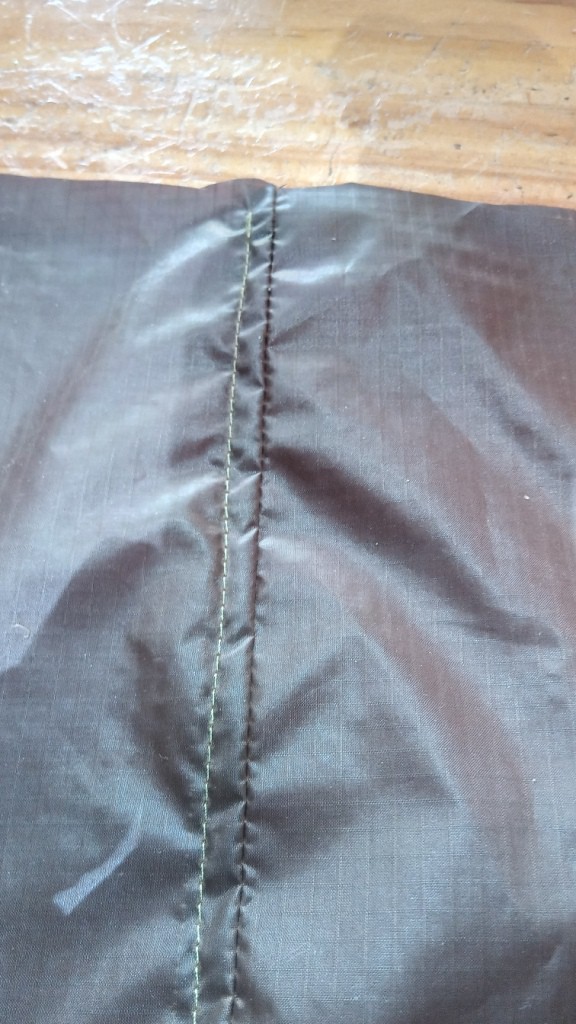
Eventually I made a table for cutting out my tents when my knees would no longer put up with all the kneeling:
Khayyam’s Table
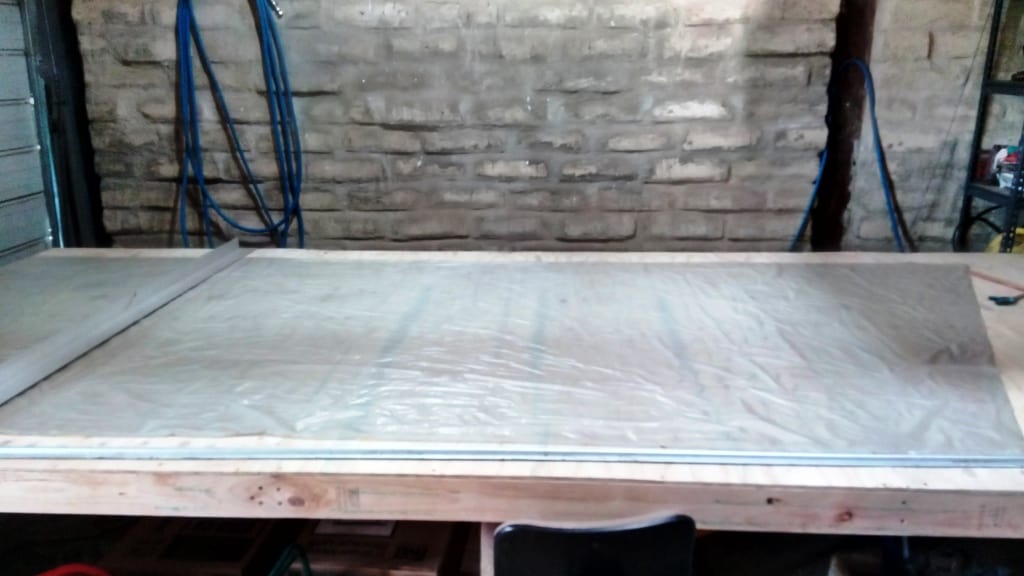
You can’t have Khayyam’s Table without Khayyam himself. What a great poem!
Oh Come With Old Khayyam
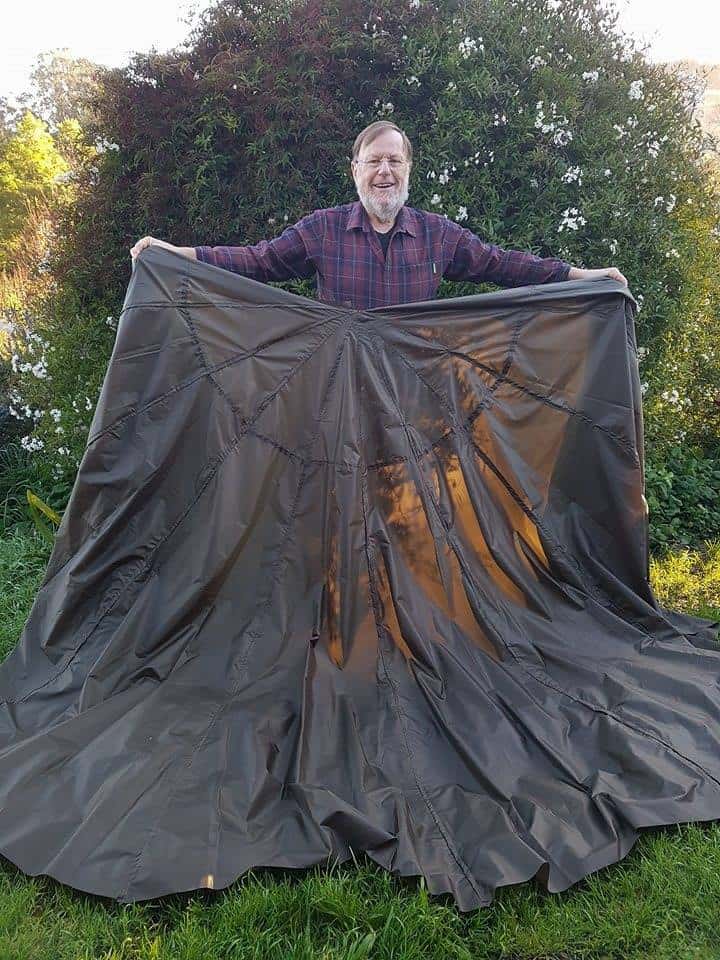
This is the way to camp out. Have done this hundreds of times yet the rain has never come in:
An Open Shelter
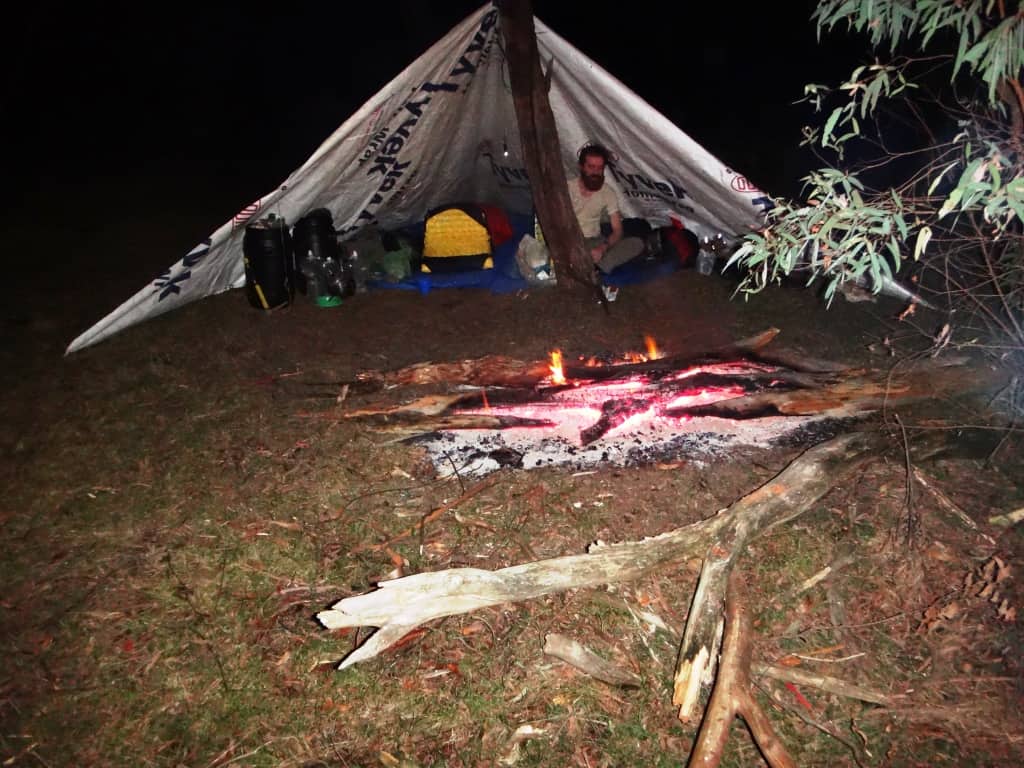
Now that’s a good fire:
Fire Tent
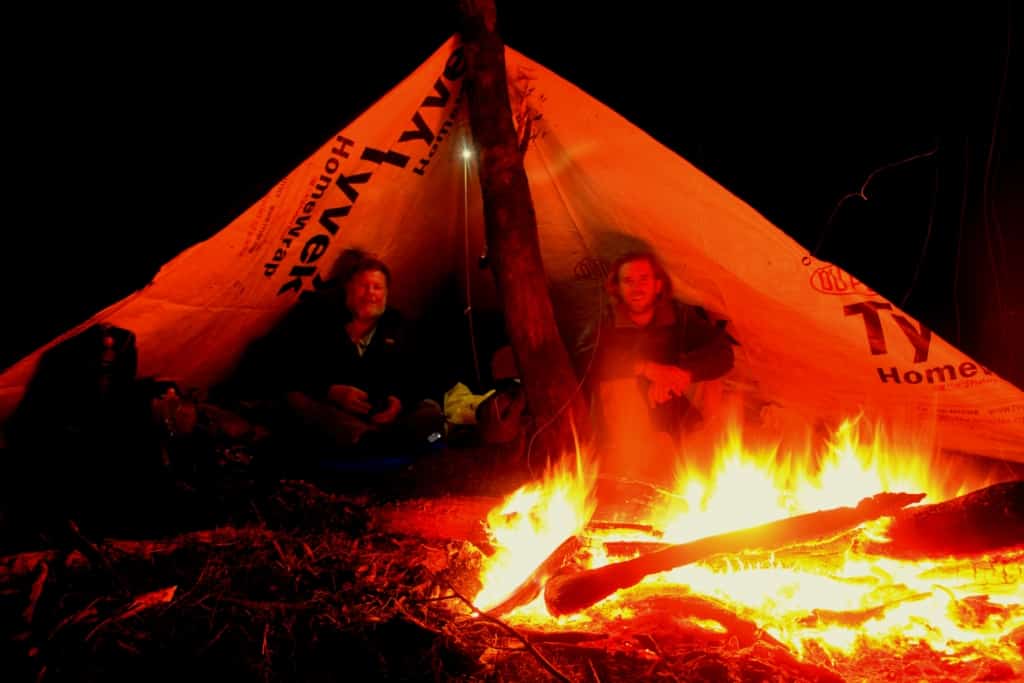
If you are going to have a ‘fire tent’ you really need to make one of these (in case of rain). Keep it well above the fire though, or make it of a fire-proof (heavier) material eg a 1 metre square ‘fire blanket’.
Fire Umbrella
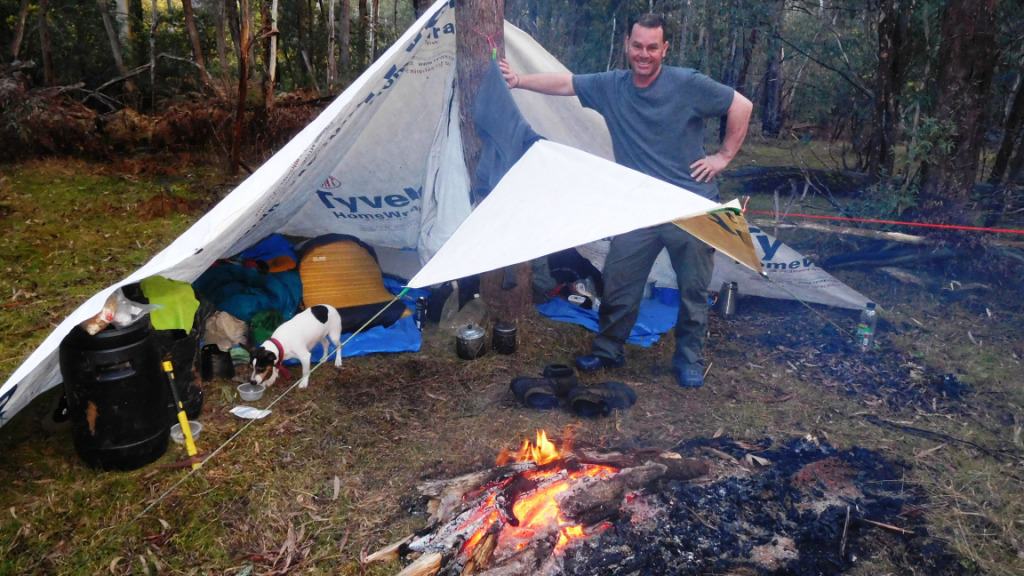
This was one of my first ‘miniature tyvek shelters:
Tyvek Solo Fire Shelter
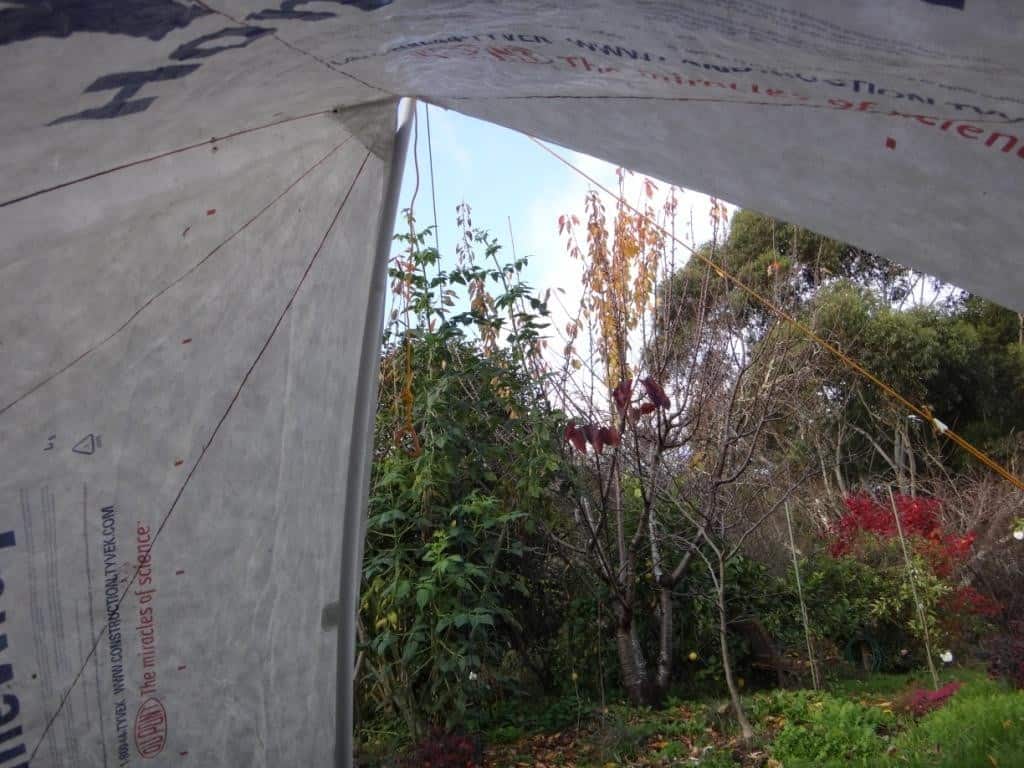
I made a larger prototype but never finished it. Found it the other day when tidying up the shed.
Tyvek Twin Fire Shelter
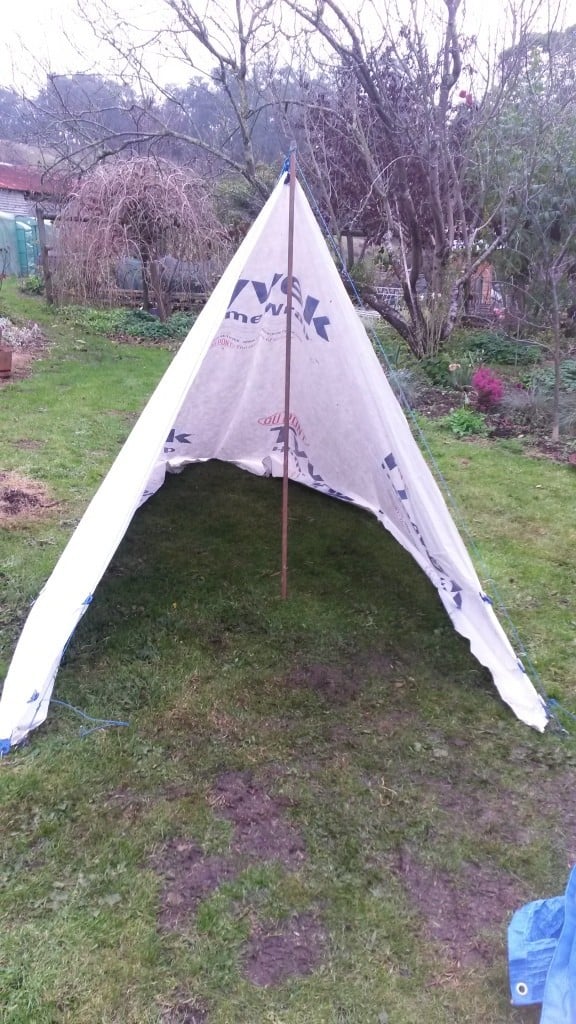
Unbelievably this one was immediately ‘snatched’ by a friend before I had a chance to perfect it.
New Tyvek ‘Forester’ Tent Design
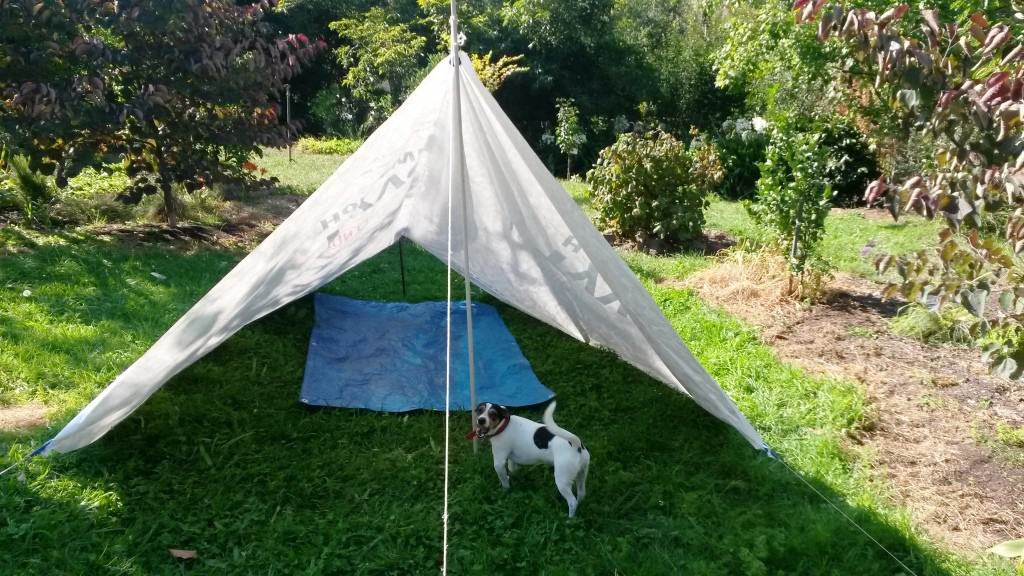
The Solo Fire Shelter (above) evolved into my first
The Deer Hunter’s Tent
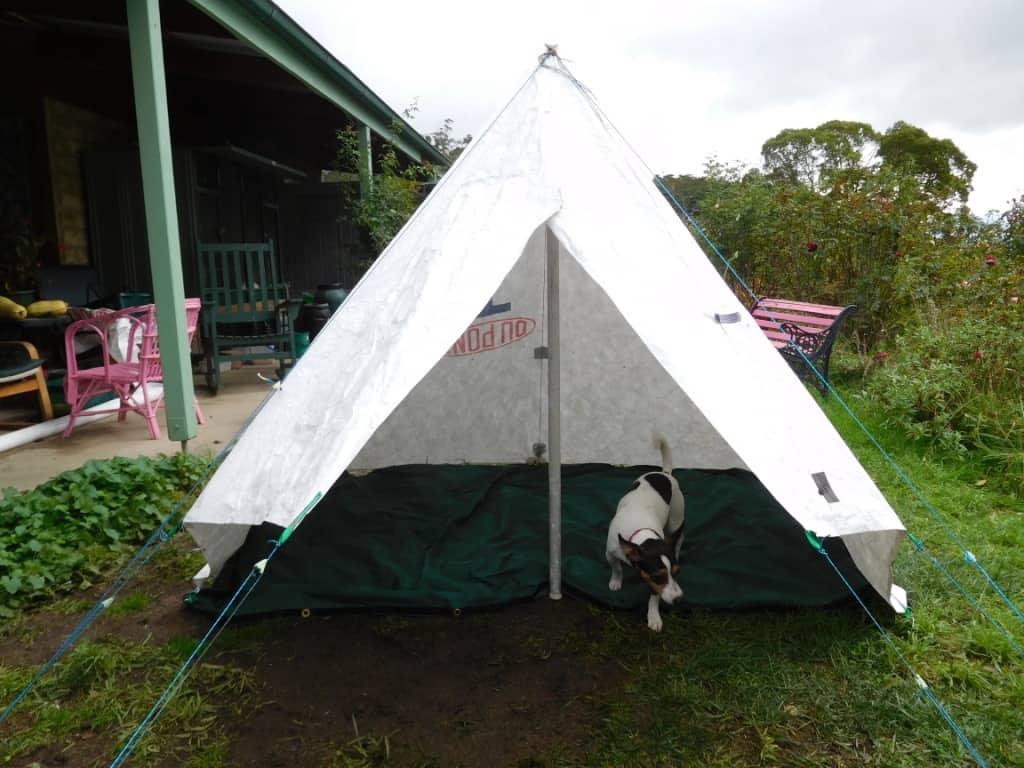
Here it is out and about (with Della and the dogs) with a sewn in floor. I will shortly be making a silnylon version of it. I think I can get it down to much more than a quarter kg.
The Last of the Mountain Men
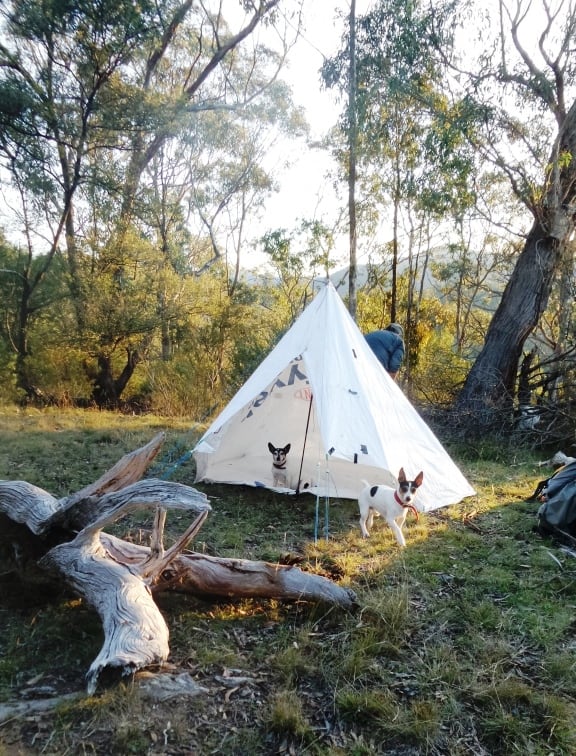
This is also just a prototype at the moment too. The problem with tipis (and pyramid tents in general) is that it rains inside them when the tent is open. I don’t want that. They give good space for weight but making them ‘wastes’ a lot of material. I may add a verandah and windows to this one and finish it off one day. It might be good to heat with my tent stove.
Seamless Tyvek Tipi
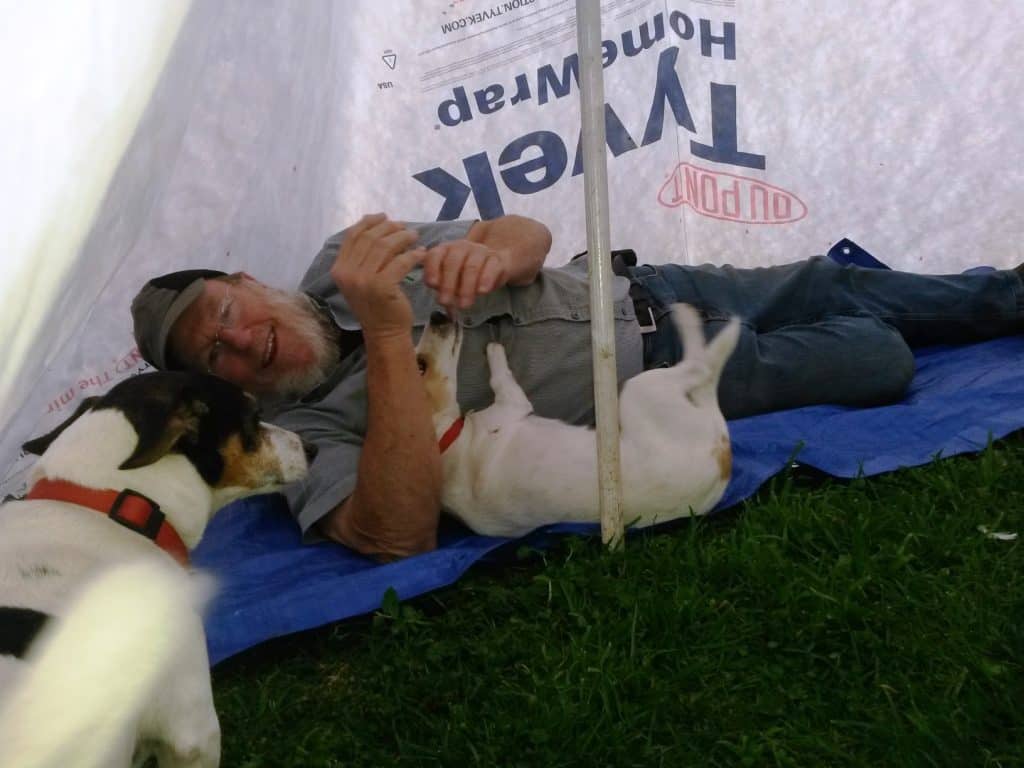
Here is another tipi design you can use (not mine)
Ultralight Tipi Tarp
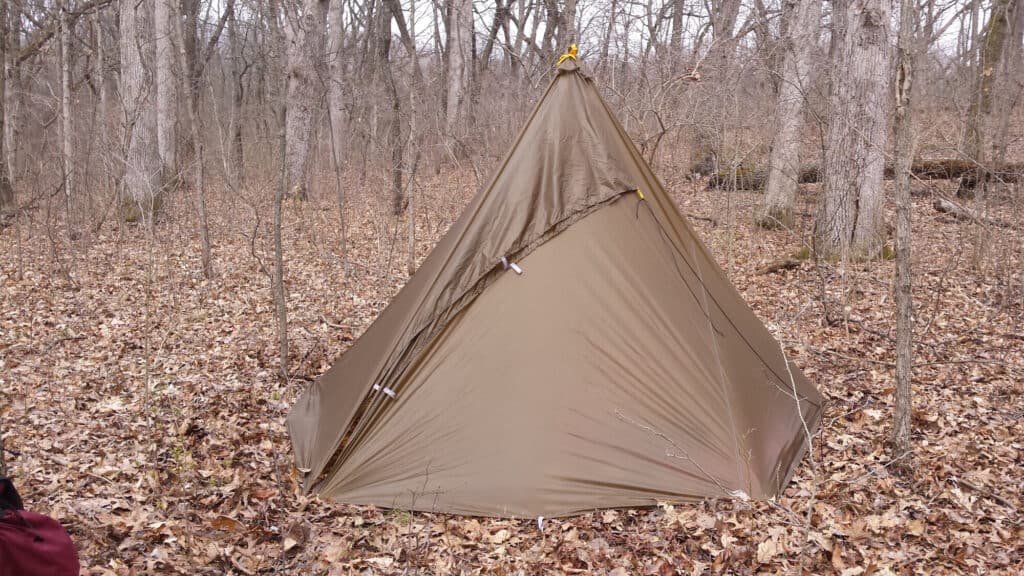
Ponchos and tarps make very useful shelter:
Pitching the Poncho: Warning: This may save your life
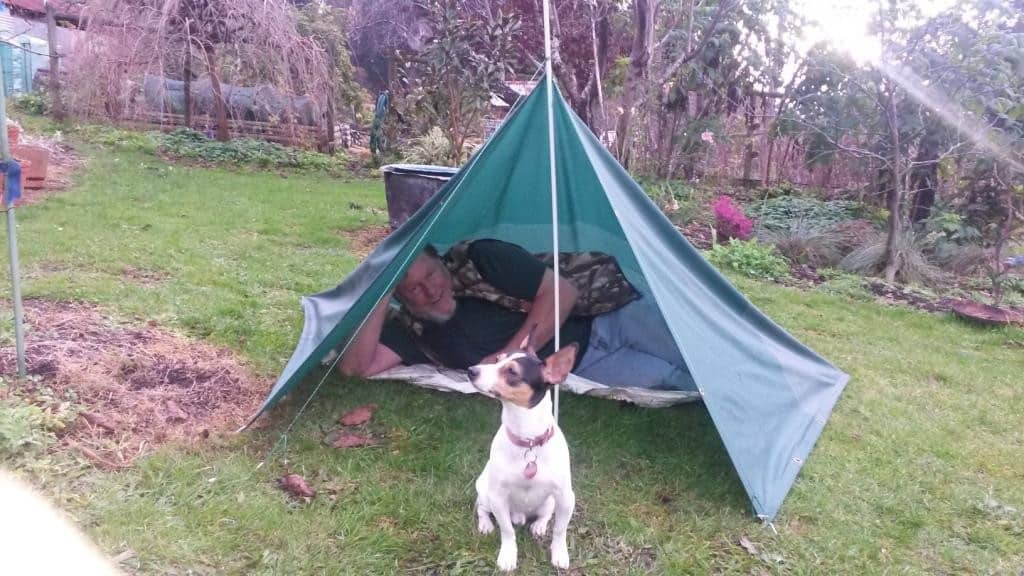
I made this one back in 1999:
Hole-less Poncho/Shelter/Hammock Tarp
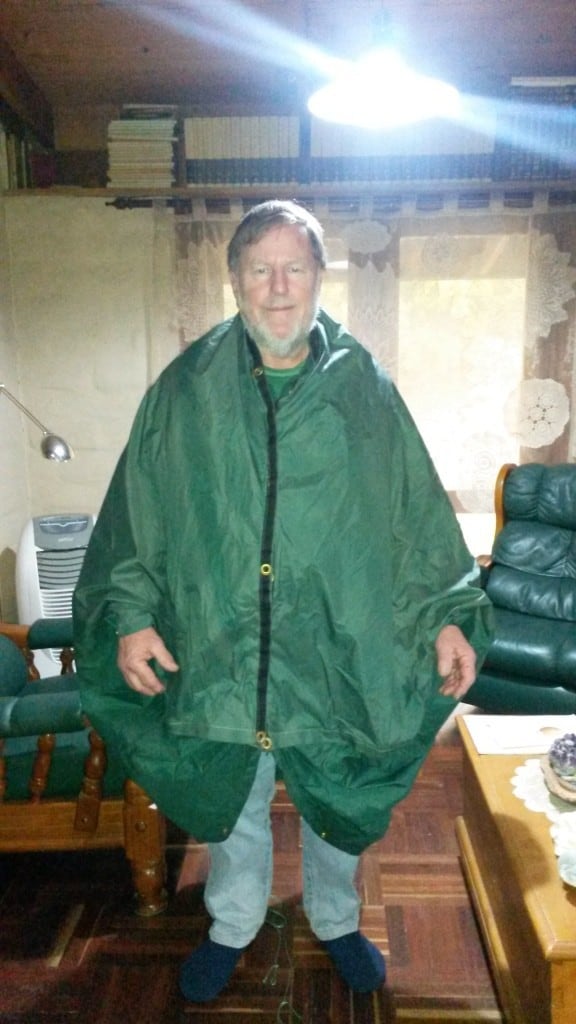
This was my improved version of it several years later. First (as usual) in Tyvek:
Ultralight Poncho Tent
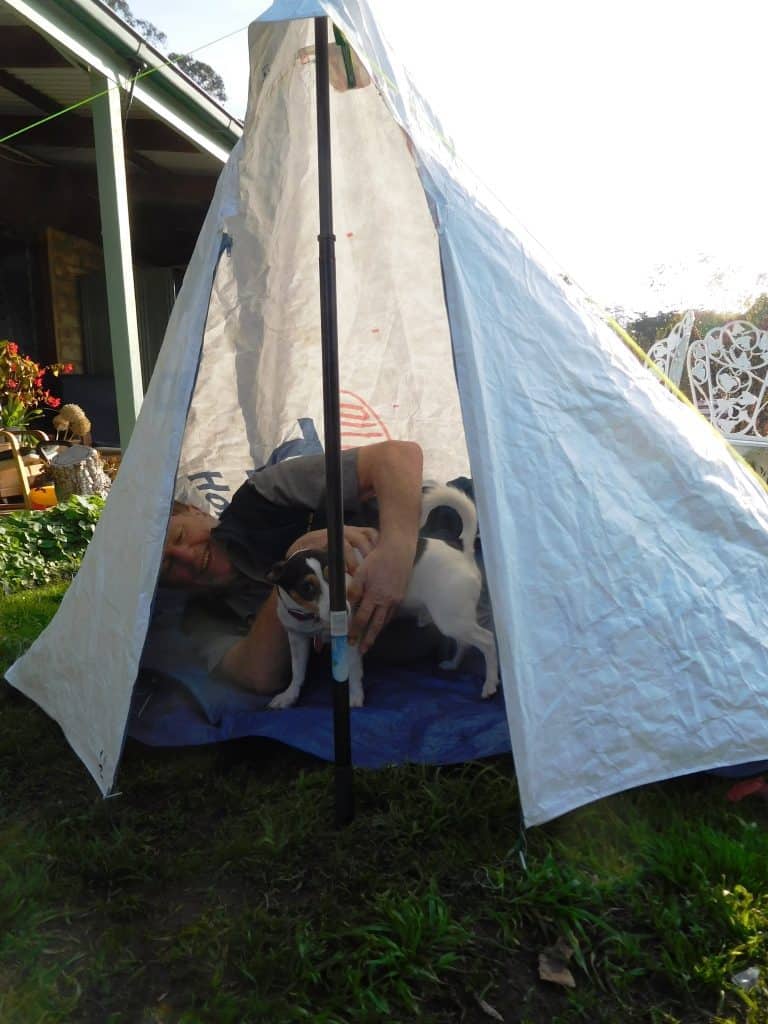
Poncho Tent Update
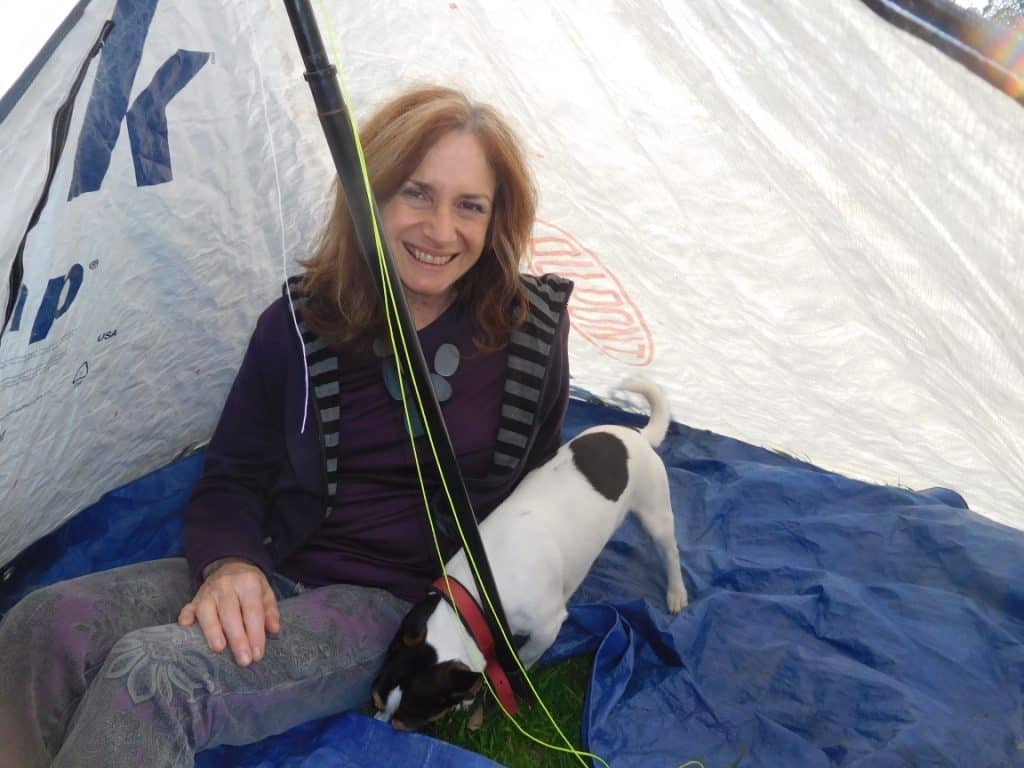
Then in silnylon (at 185 grams in 1.3 oz/yd2 material). I will ‘stretch it a bit to see if Della and I can both fir=t into an new model. In the .77 oz/yd2 material (i calculate) a larger version will weigh < 120 grams (with guys). It would be good to carry as an emergency raincoat & shelter in case something awful befalls one of these items when we are on a multi-day trip far from tracks, trails or human contact – as we still love doing!
The Pocket Poncho Tent
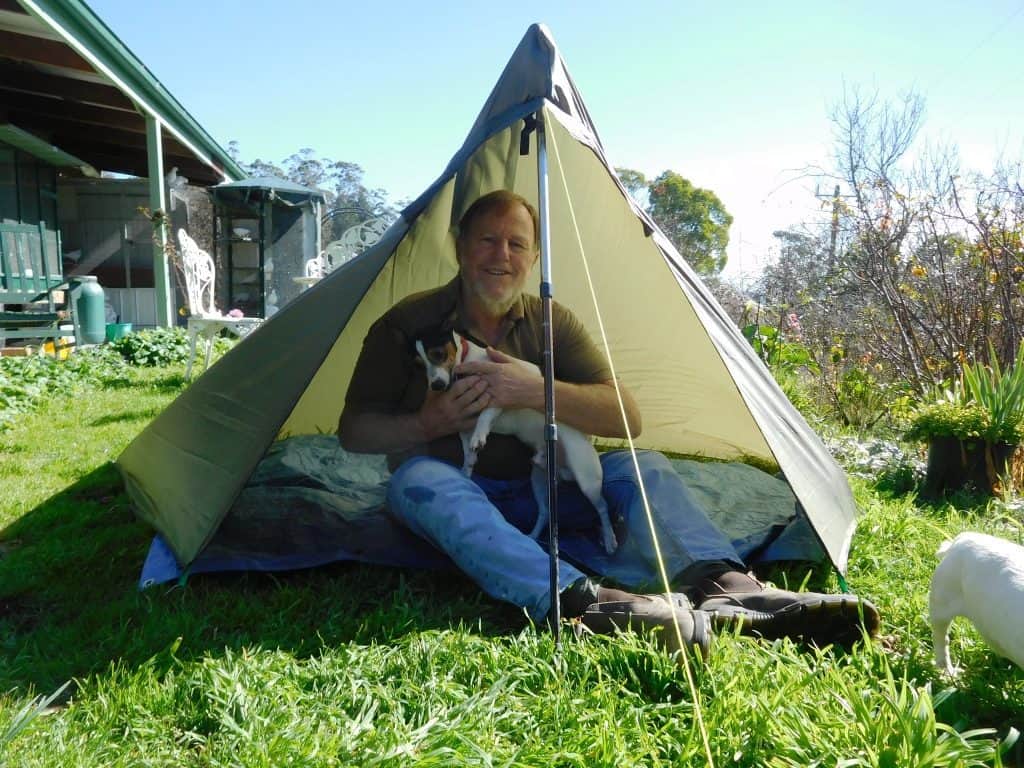
This was my idea for an ‘improved’ tipi – one that sort of ‘leaned over’ so that it had a kind of verandah to prevent rain from falling inside when the door was open. It worked really well, so I made a smaller version and then finished it in Silnylon – the Siligloo.
New Decagon Octagon Tyvek Igloo Tent Design
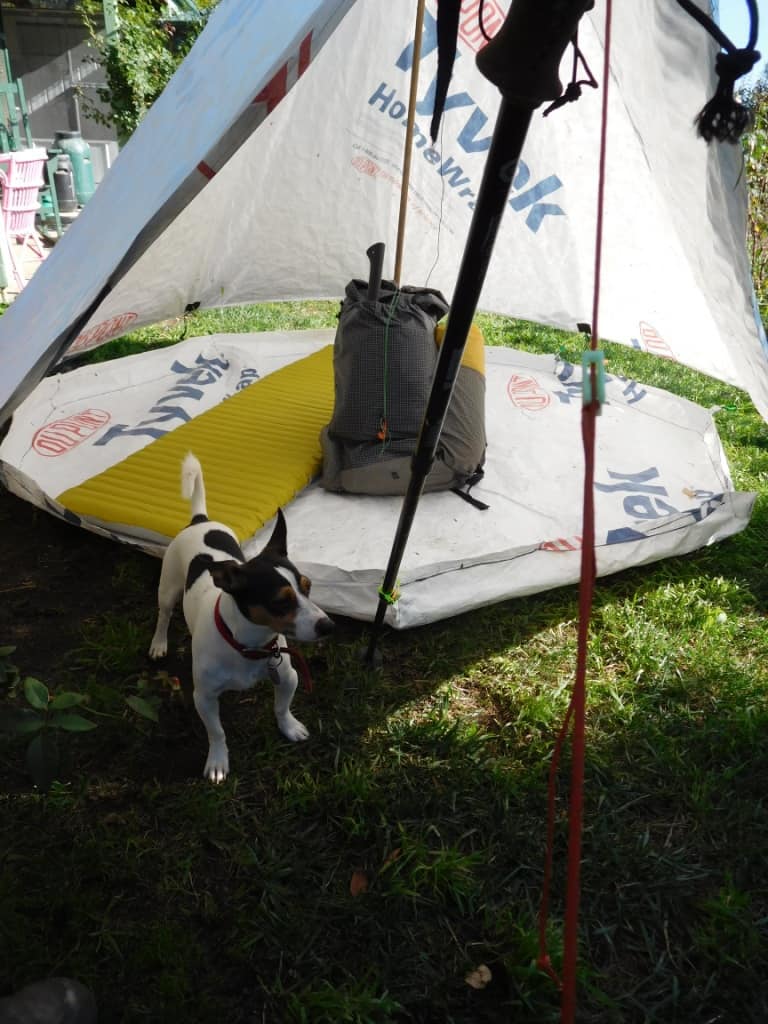
Honey, I Shrank the Tent
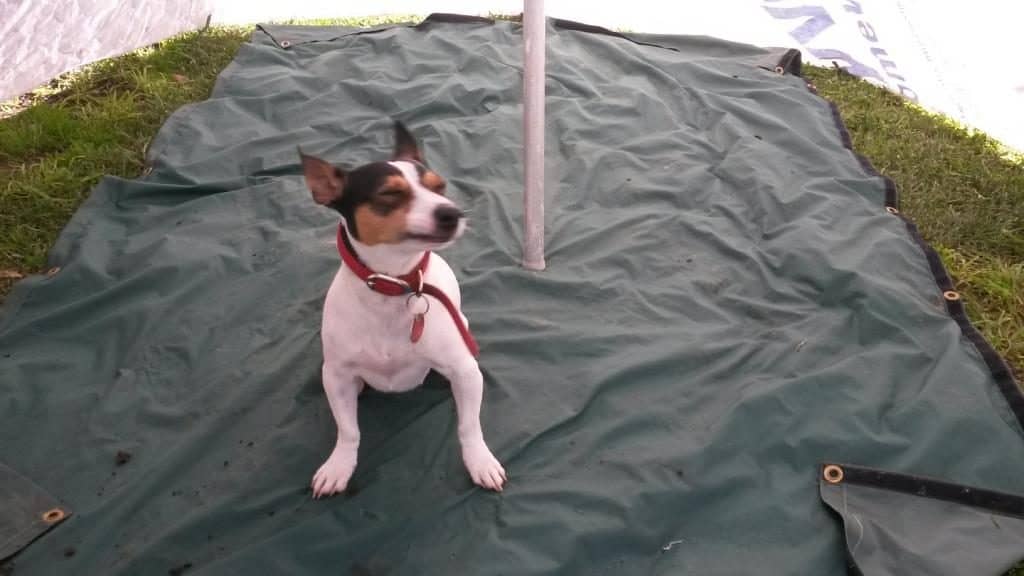
Siligloo
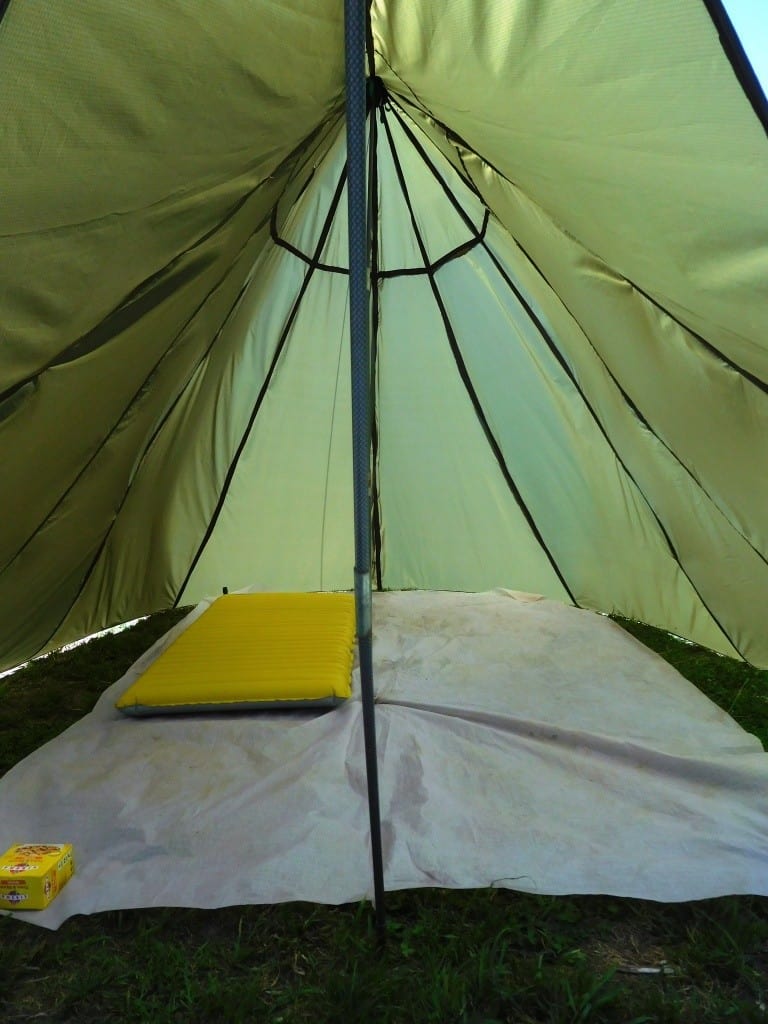
Then I made a bathtub floor for it. This has been an excellent airy, roomy tent.
Ultralight Bathtub Floor
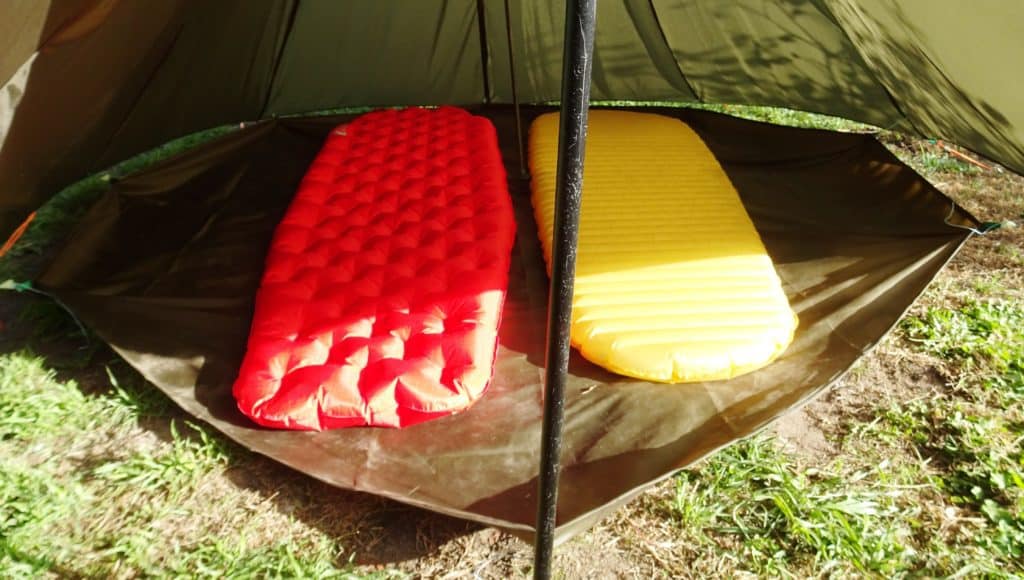
Here it is out and about.
Wilderness Siligloo
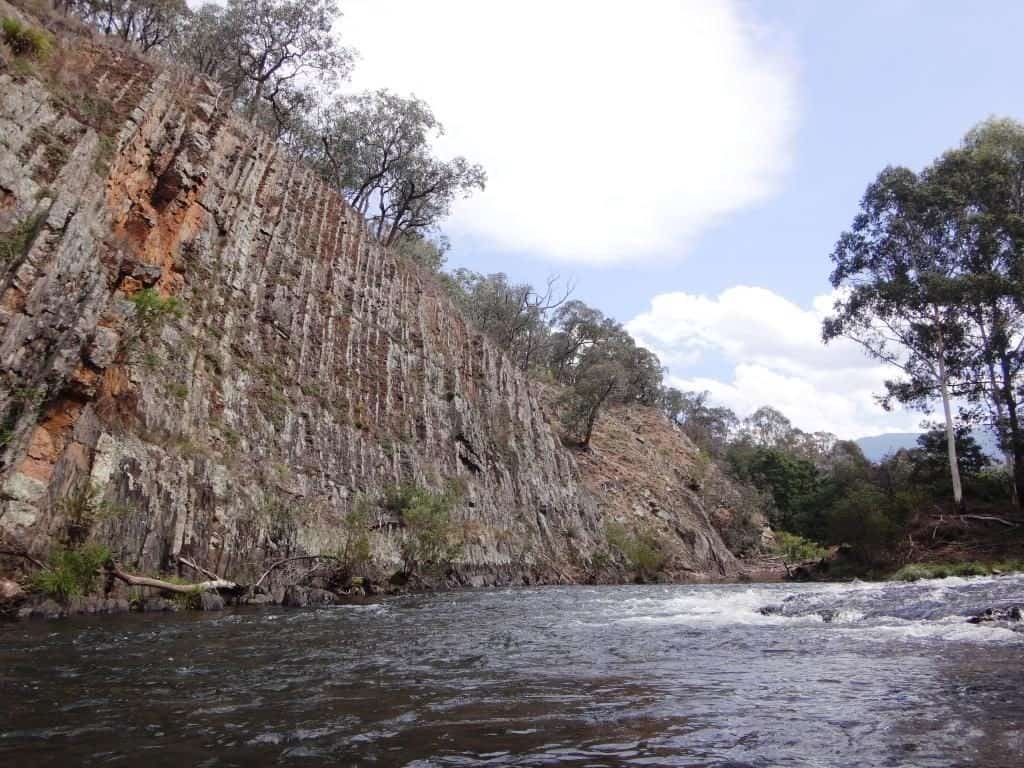
I haven’t made the second ‘configuration’ yet, so this is the 10 x 10 hammock tarp prototype – worked really well too. As you can see, you can pitch it as a tent or as a hammock tarp.
Two Great Poly Tarp Configurations
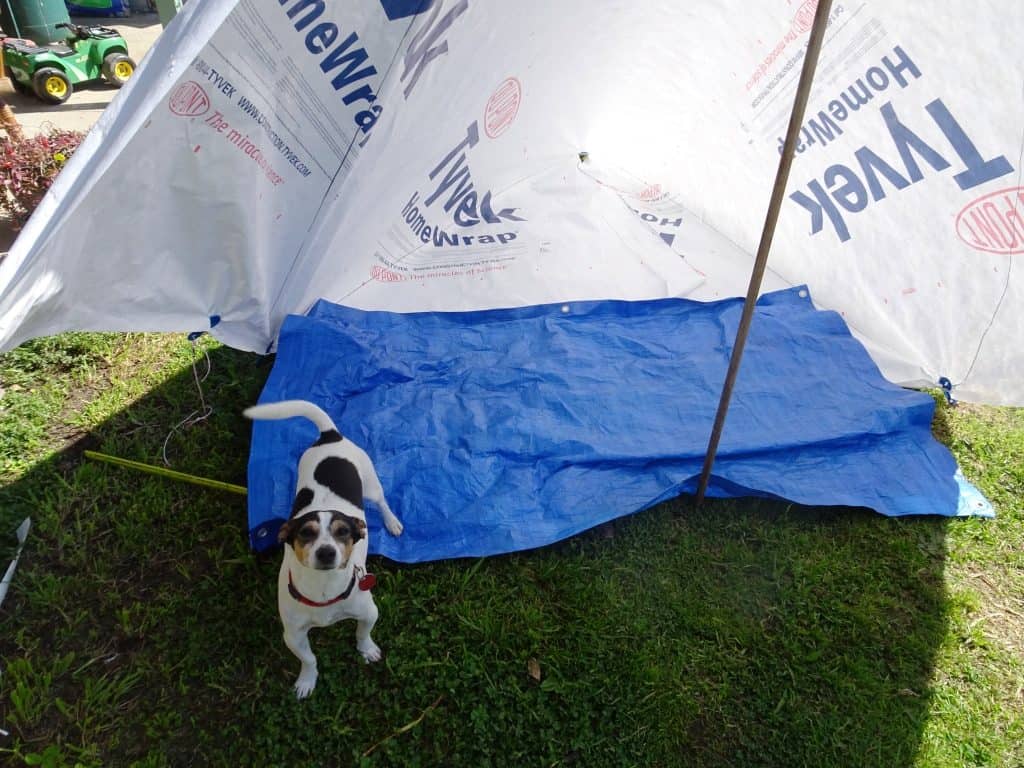
10 by 10 Tarp Update
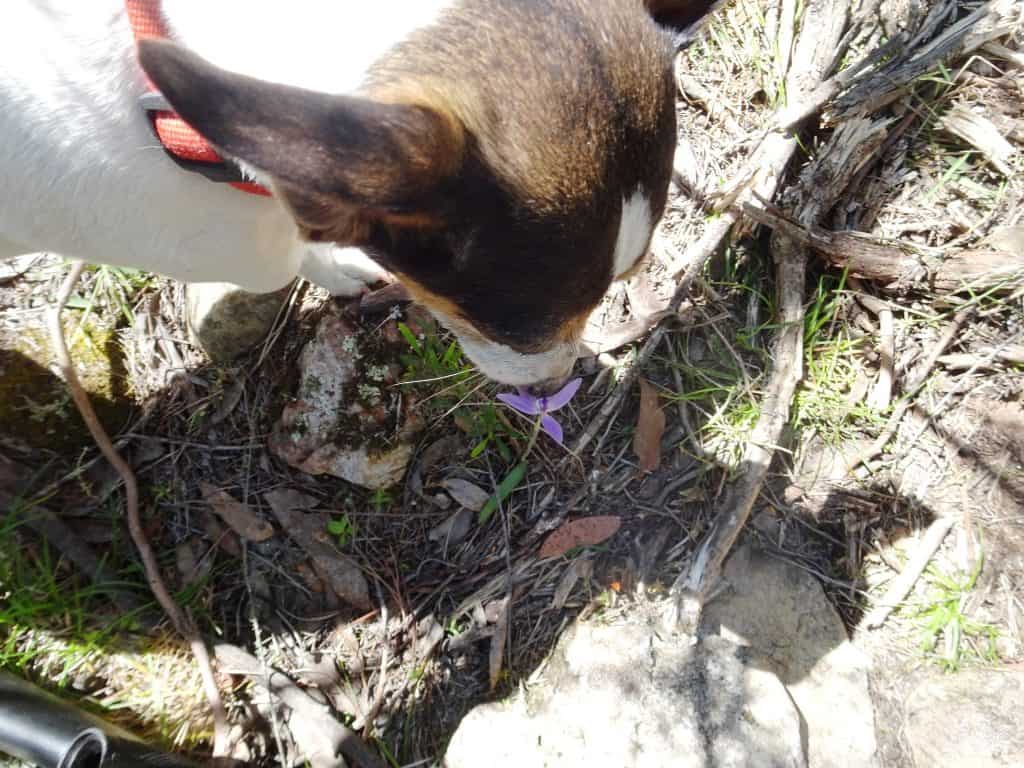
Out and about with the 10 x 10 tarp.
The Valley of the Deer
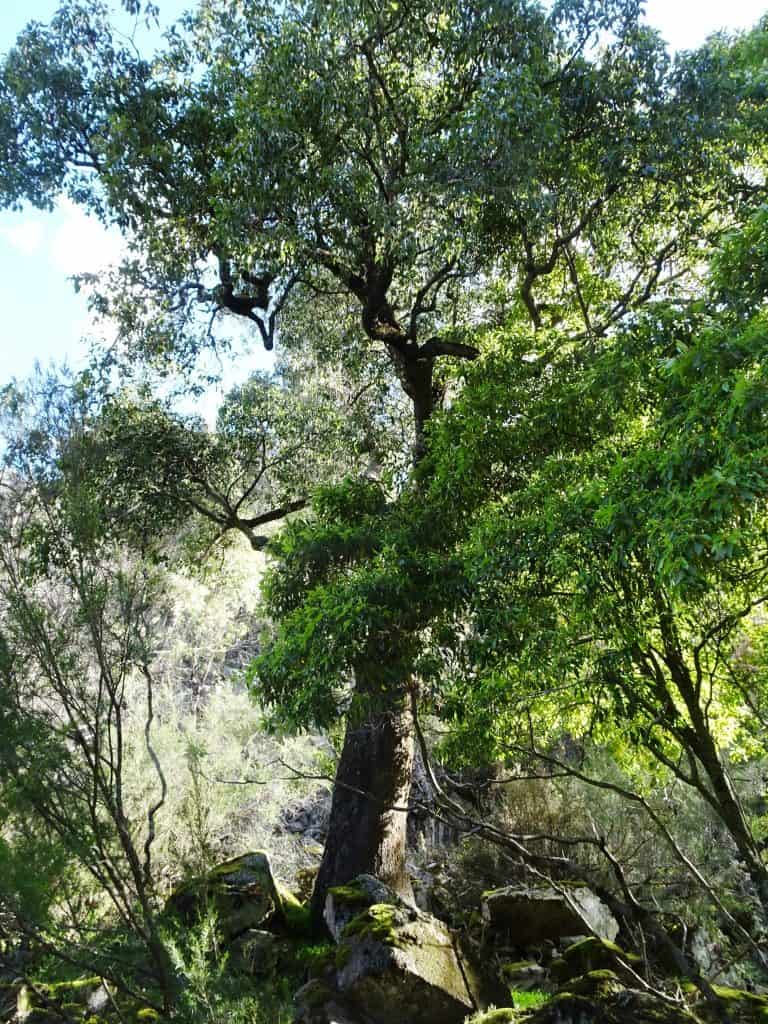
I liked it so much I made a silnylon version:
Silnylon Hammock Tent
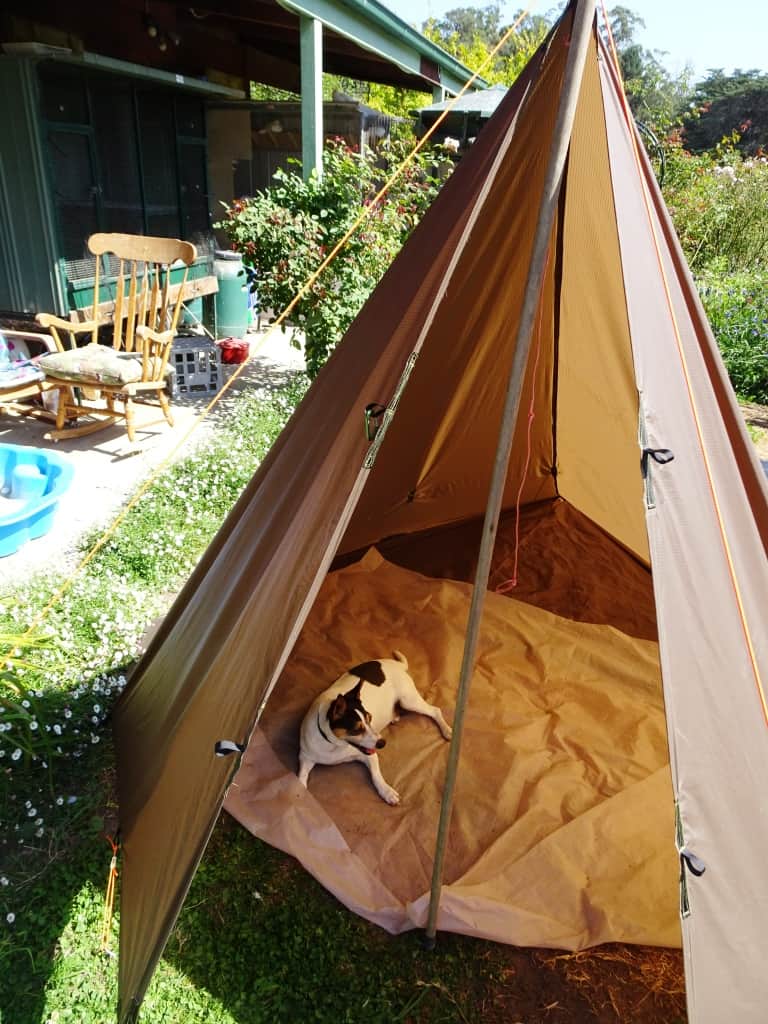
I then realised I could combine some of the ideas in the original Deer Hunter’s Tent with the 10 x 10 tarp to make a tent that was also a hammock tarp. This version is huge – easily big enough for three.
Deer Hunter’s Tent #2
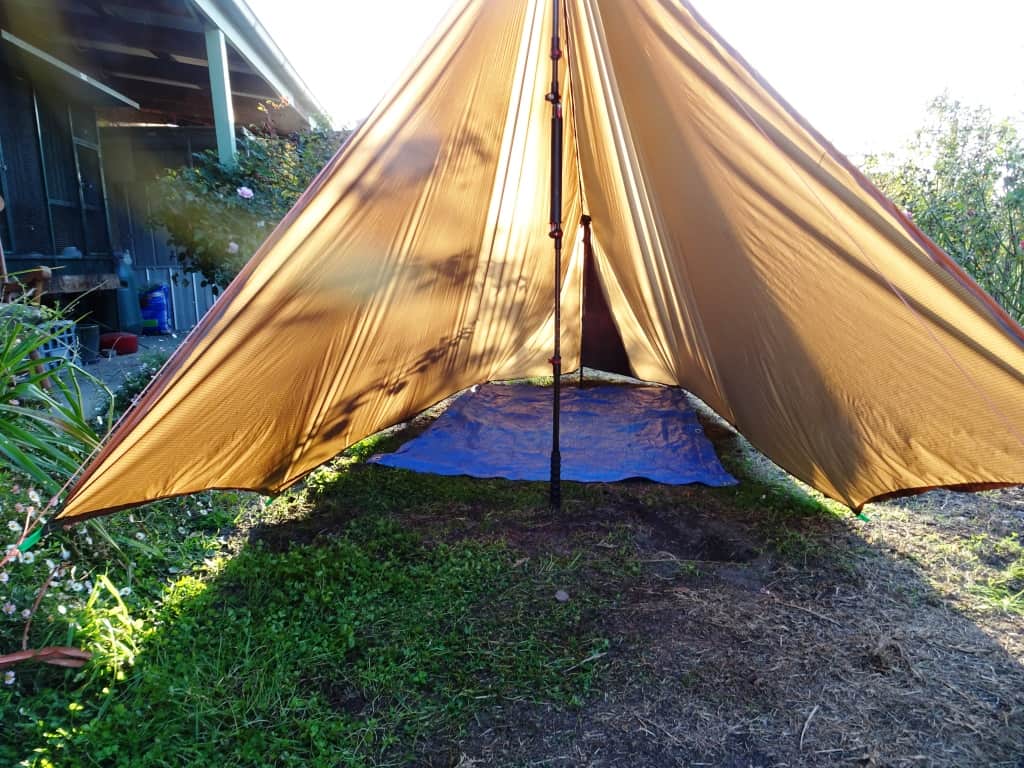
Deer Hunter’s Tent Goes Bush
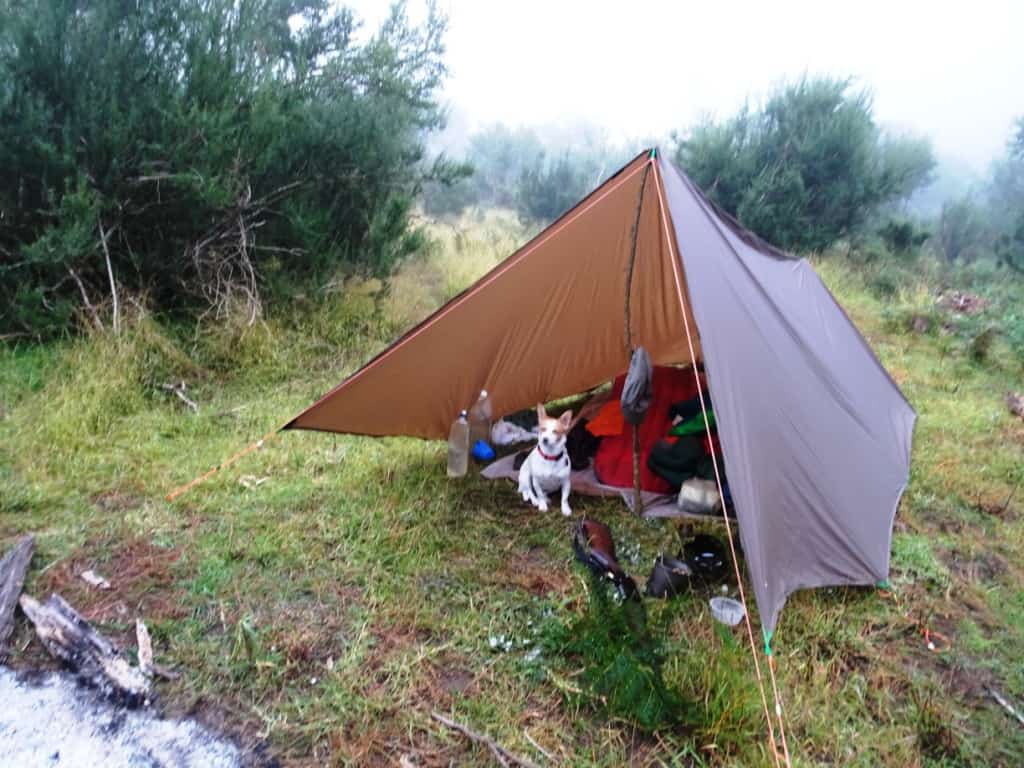
This is my ‘latest’ iteration. It is basically a ‘shrunk’ version of the Deer Hunter’s #2. A ‘fire tent’ for two plus two small dogs and lots of spread out gear which can be left open yet the rain does not come inside – and it doubles as a hammock tarp (also for two!) It is just great. I doubt I (or anyone else) will better it – except by making it from even lighter fabric, which I will. I will get the ‘roof’ part down to 200 grams and the ‘floor’ to 100 with about 60 grams of pegs = 360 grams complete! Add an Ultralight Hammock for each at a little over 100 grams and you will have a pretty ‘bulletproof’ setup.
The Grey Flyer
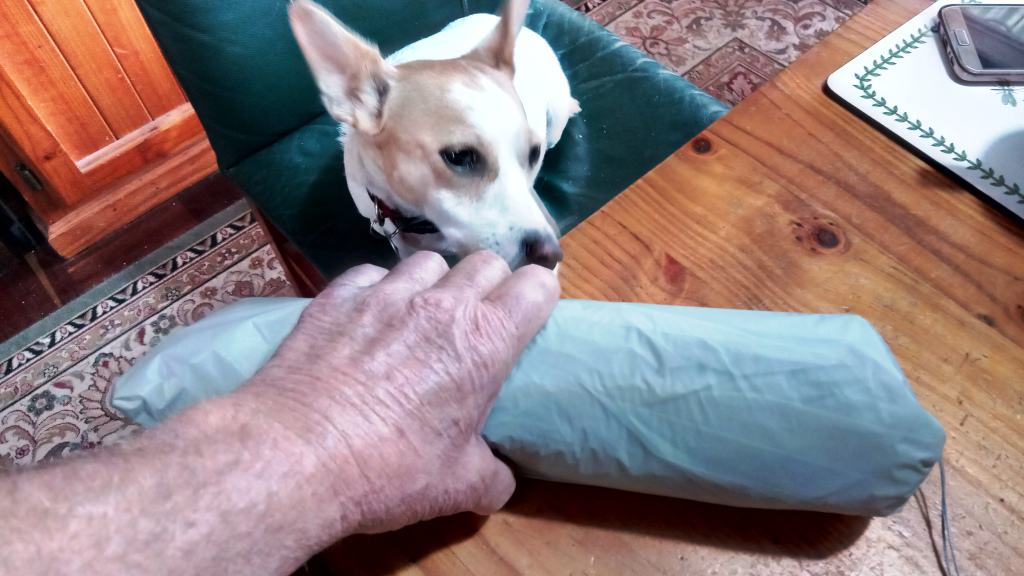
It started life as this prototype:
Miniature Whelen Hammock Tent
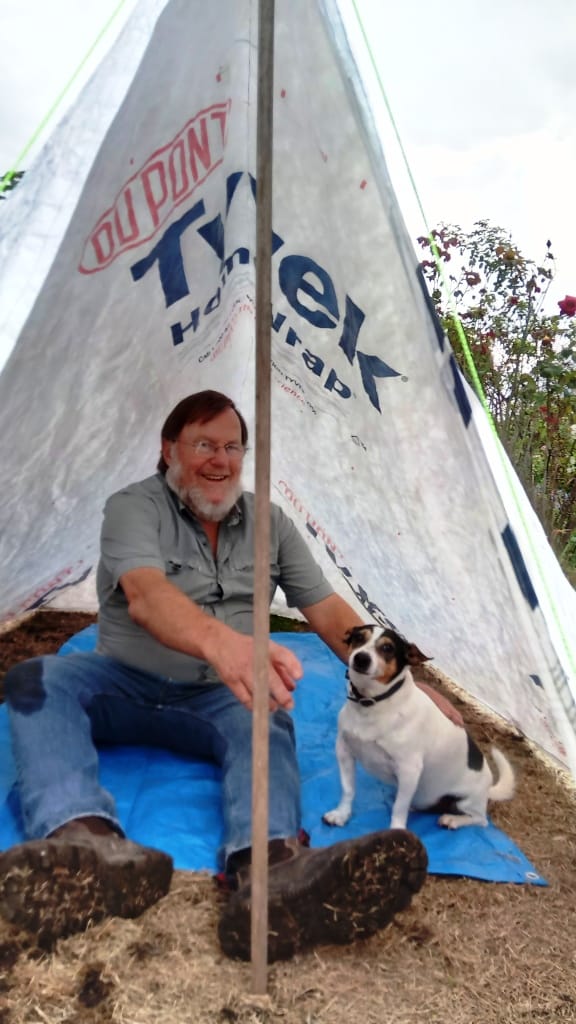
Here it is out and about:
High Flying
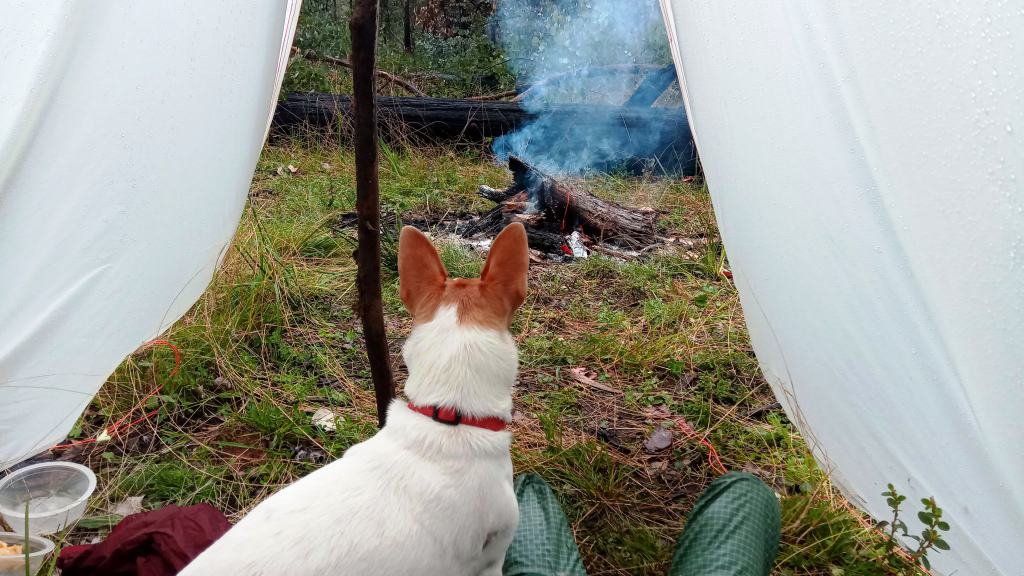
Zpack Plex Solo Tent
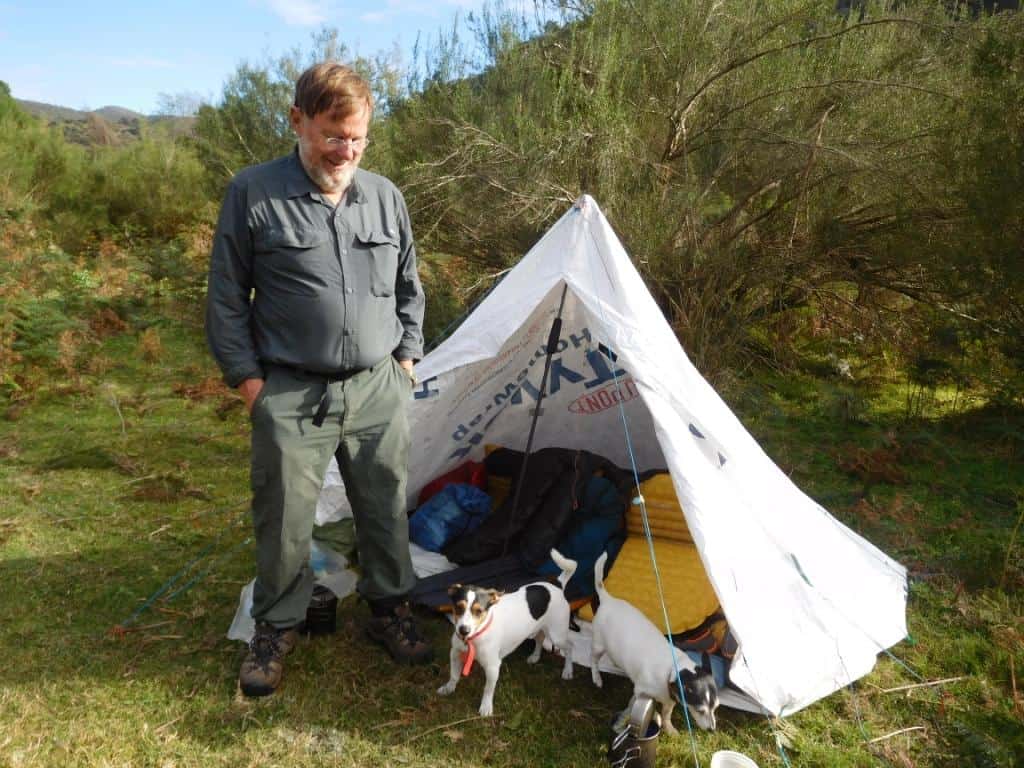
Bugmesh on Steroids
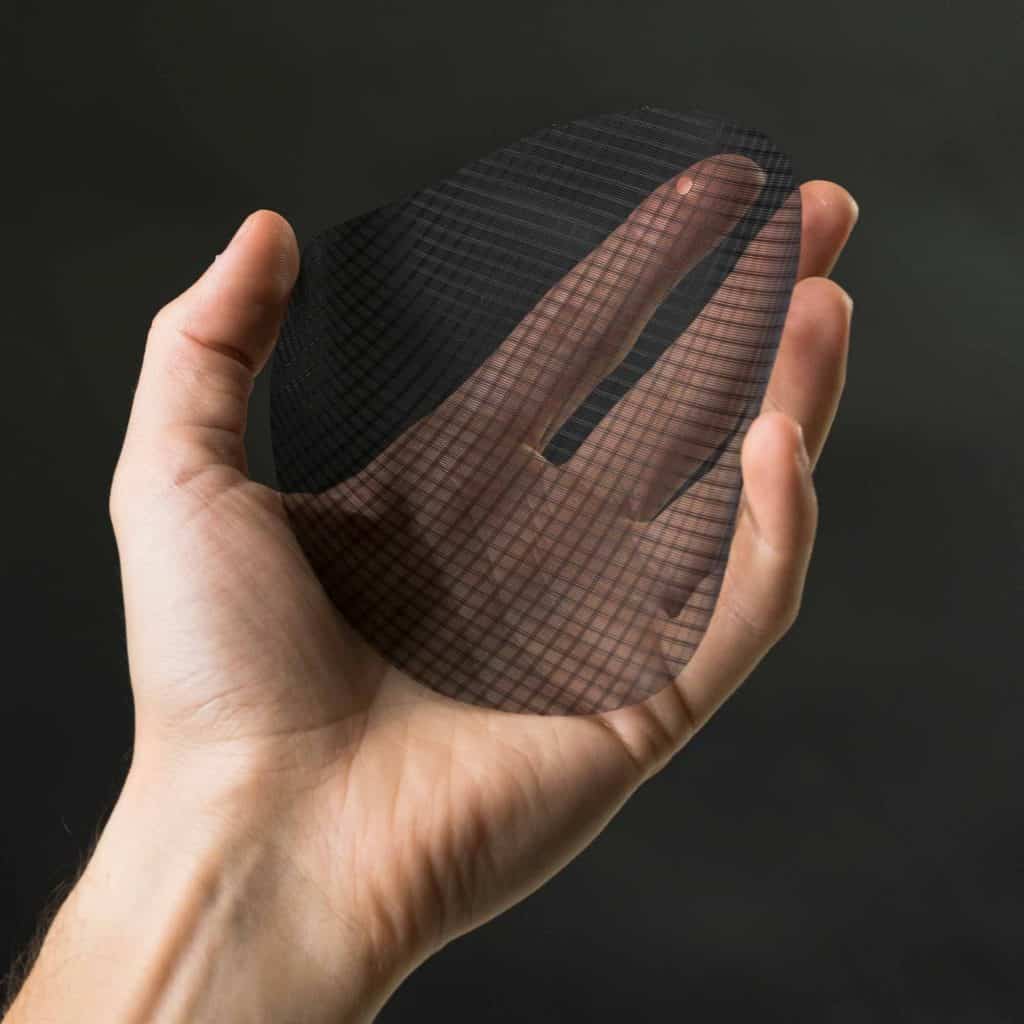
You really need to secure your tent:
Windy Old Weather
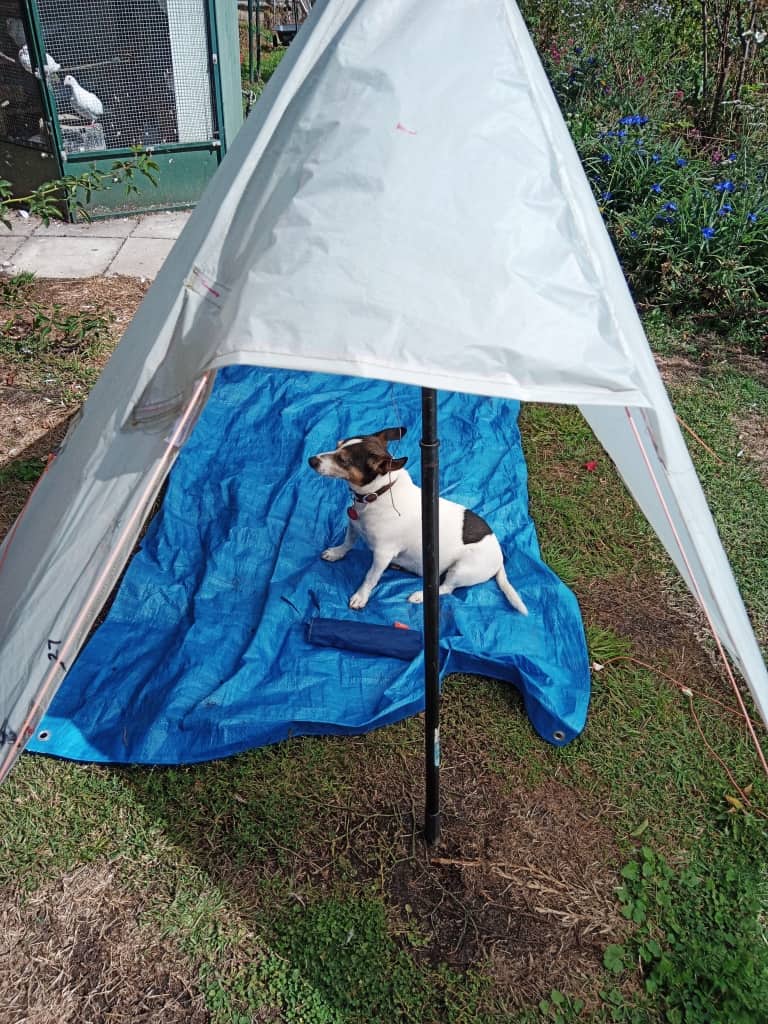
Just a couple of ‘tips’ about tent poles:
How to Make a Tent Pole
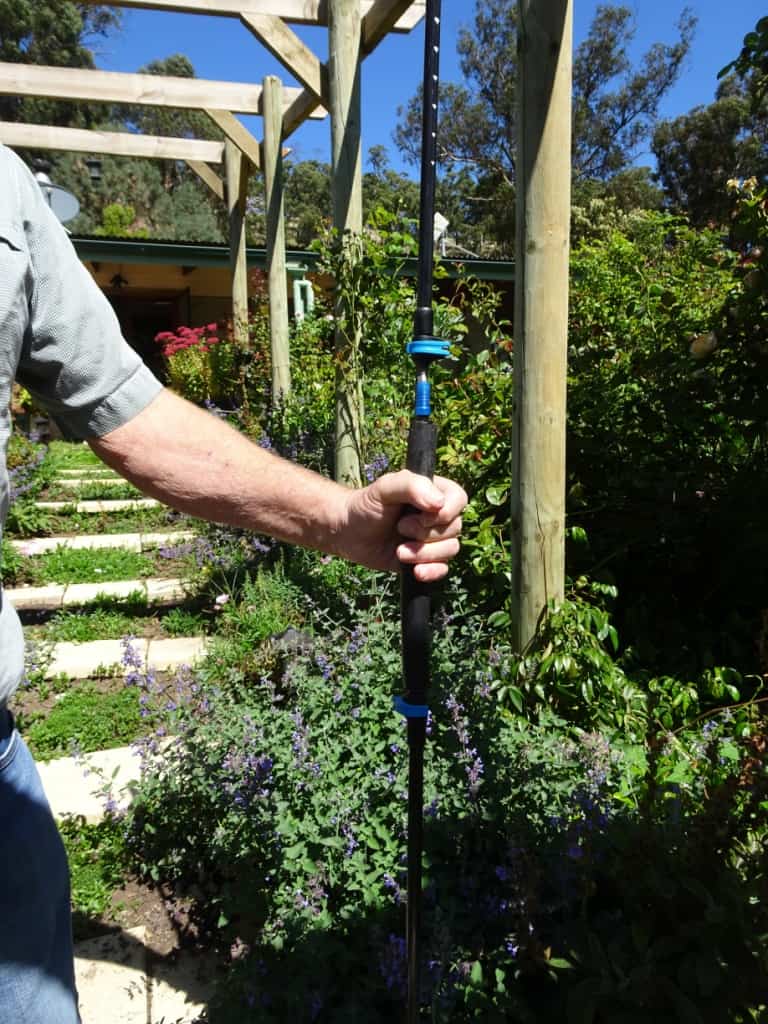
Ultralight Tent Poles
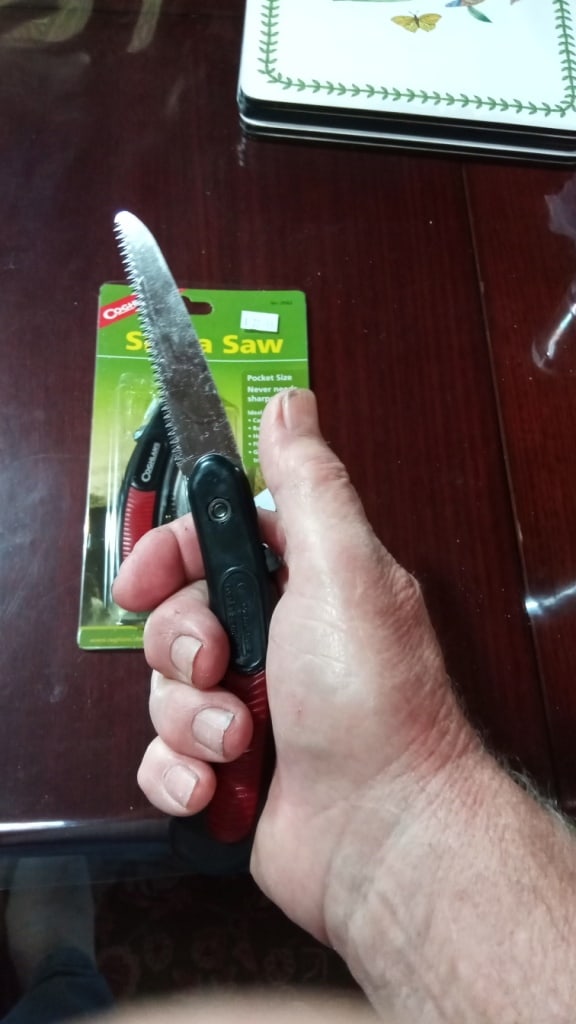
Do You Need a Bug Net or a Tent Floor
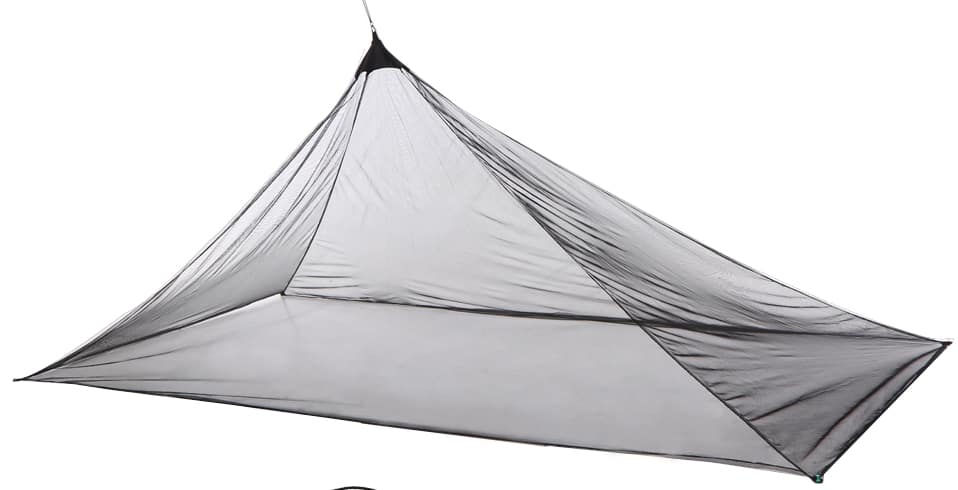
Of course if you use just a tarp, you will still want a ground sheet:
Ultralight Ground Sheet
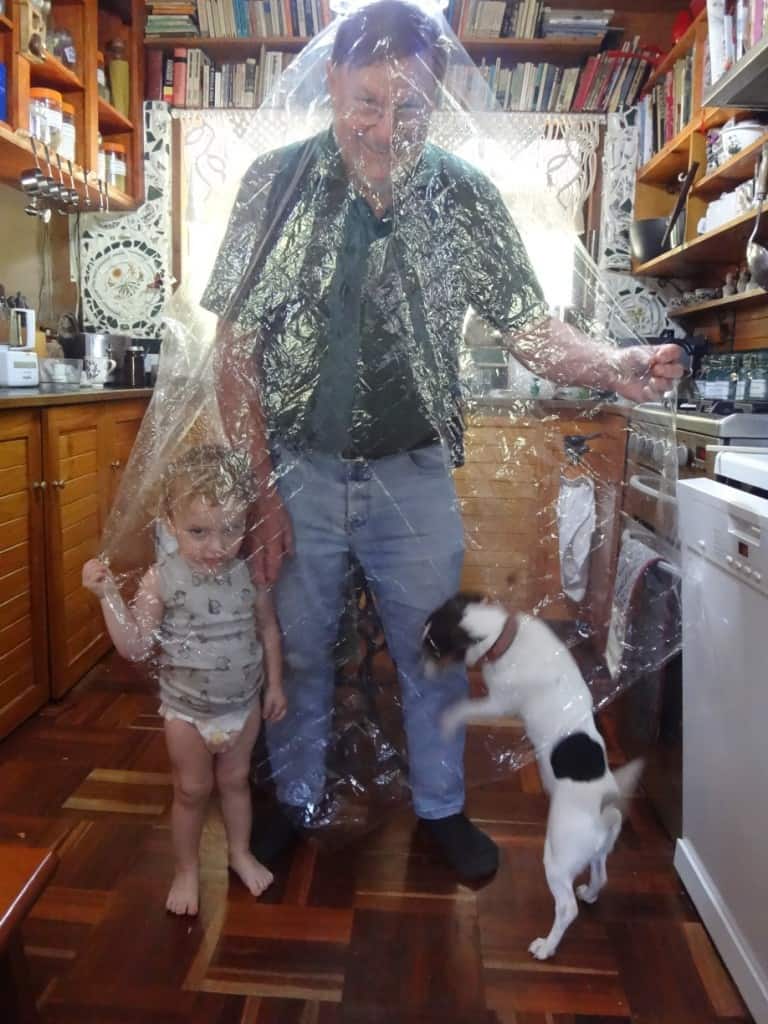
Simple Ultralight Groundsheet
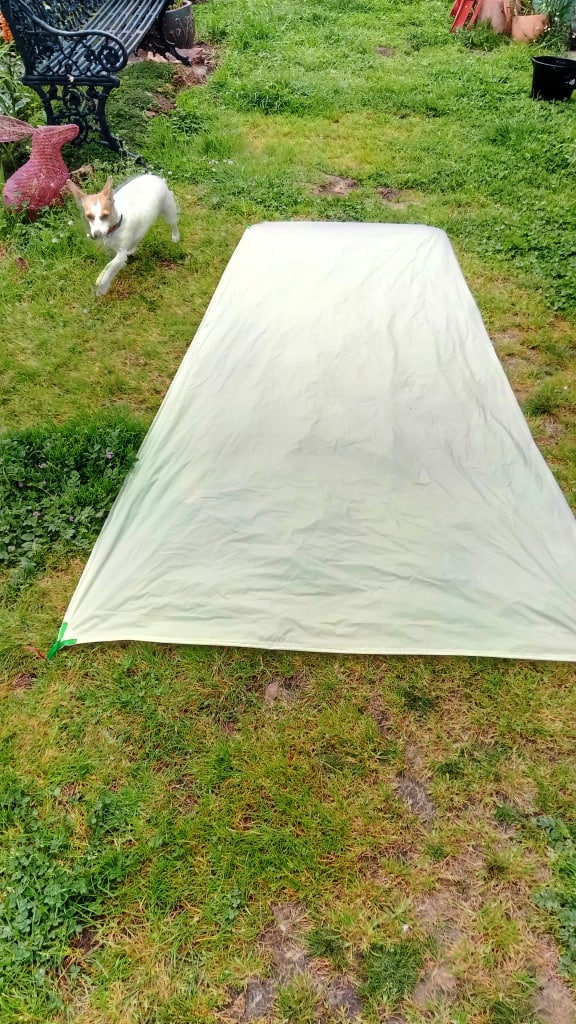
Of course you could just buy one:
Cheap Ultralight Bathtub Floor
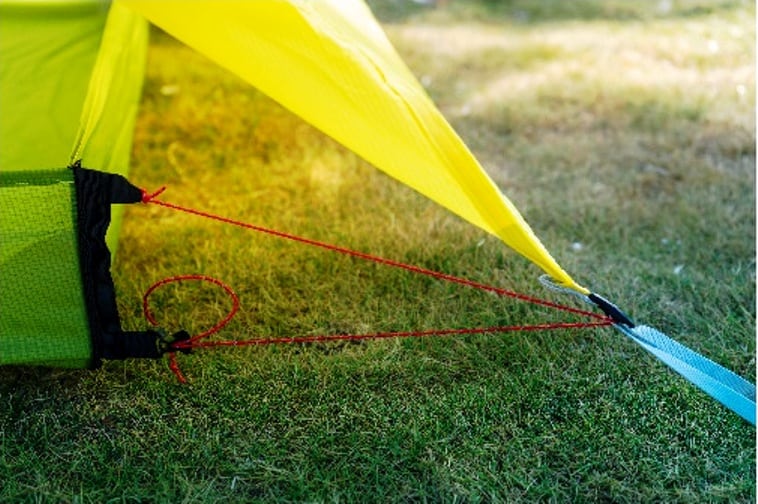
This is a great tip:
Waterproofing Tent Floors and Ground Sheets
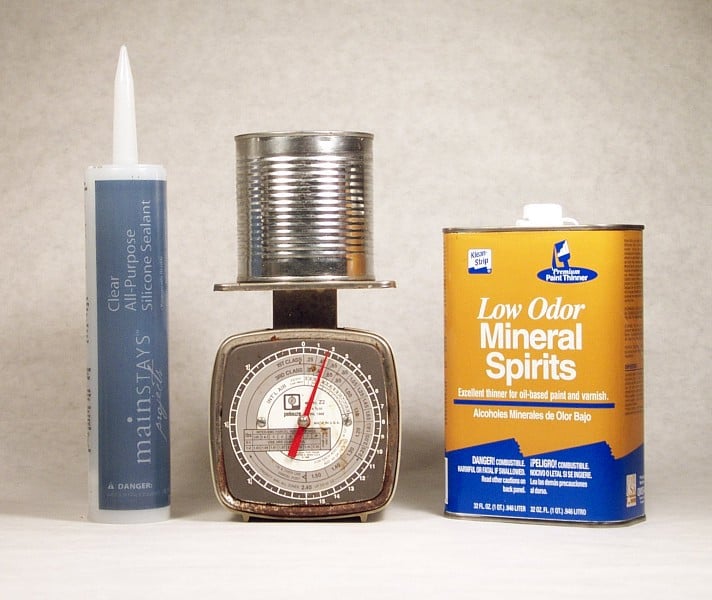
I really do have to go back to this idea and finish it:
Bathtub Groundsheet Chair
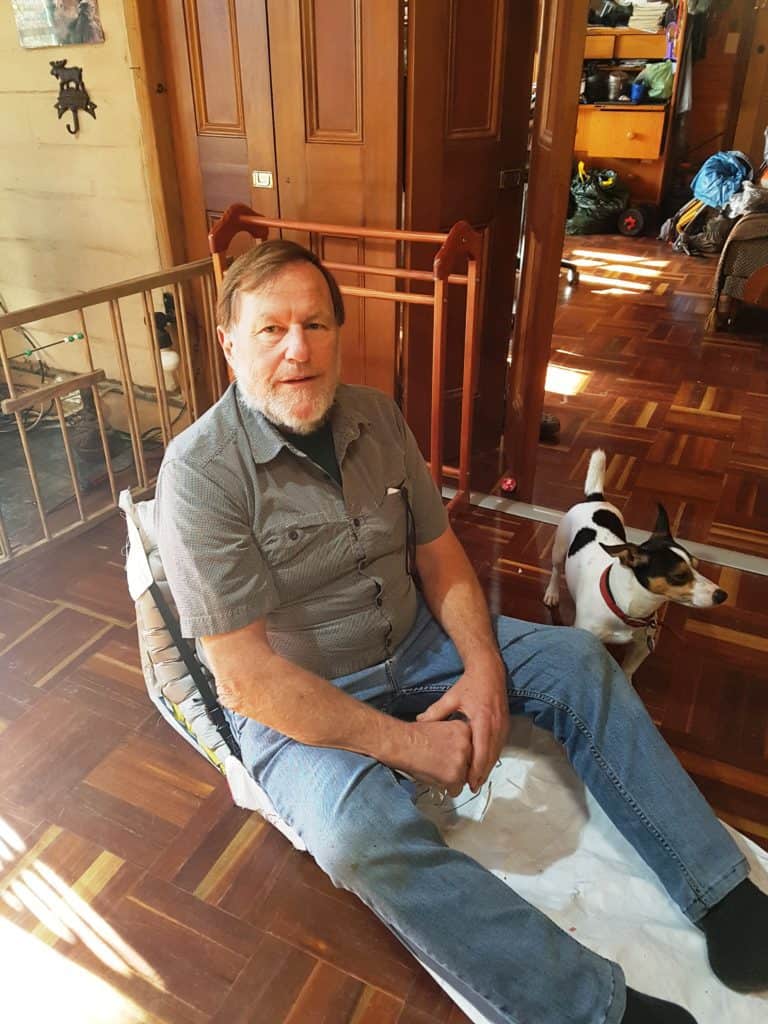
and this one (I have nearly figured out how to do it in ultralight):
Inflatable Bathtub Groundsheet
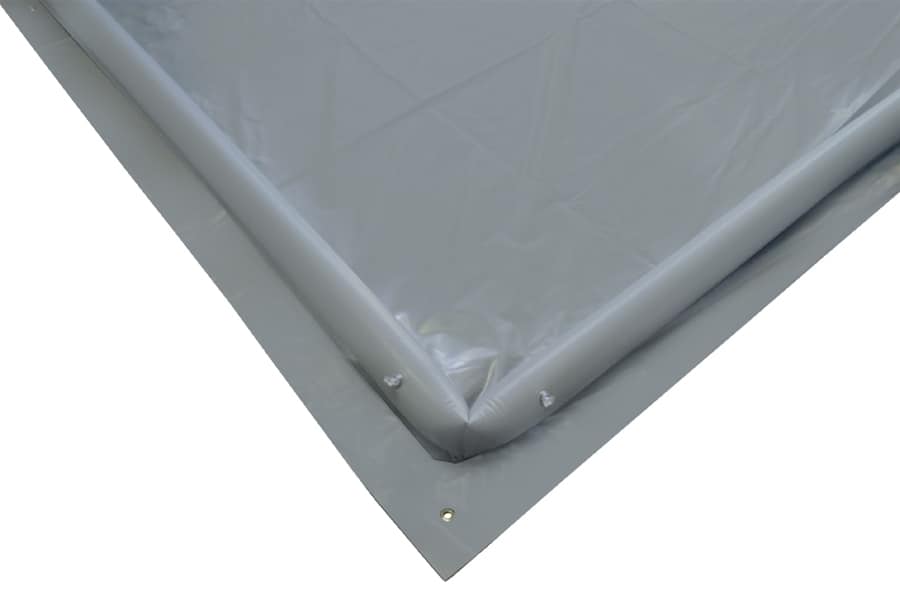
though I did make this ultralight chair (50grams) which worked:
Nano Chair #2
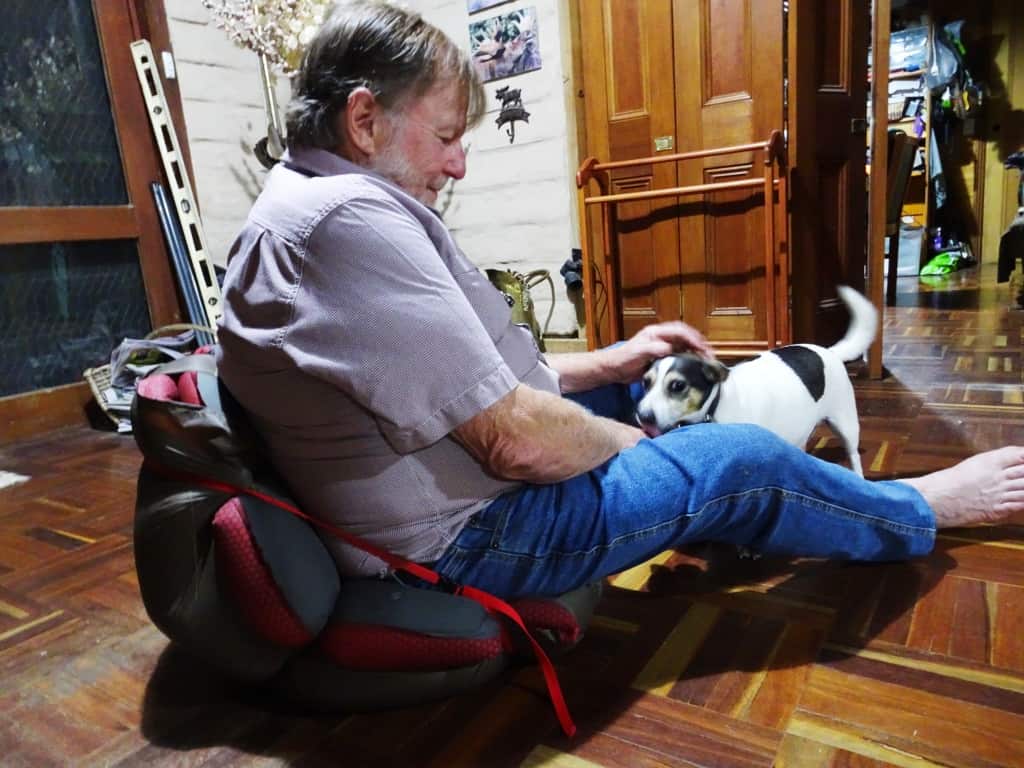
This is also a good idea. I did make one in Tyvek but don’t seem to find any post about it Or the thing itself actually:
Tarp Bathtub Groundsheet
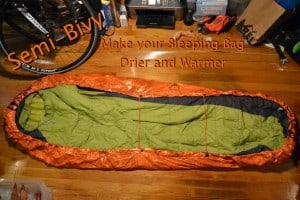
Inflatable Space Blanket Quilt
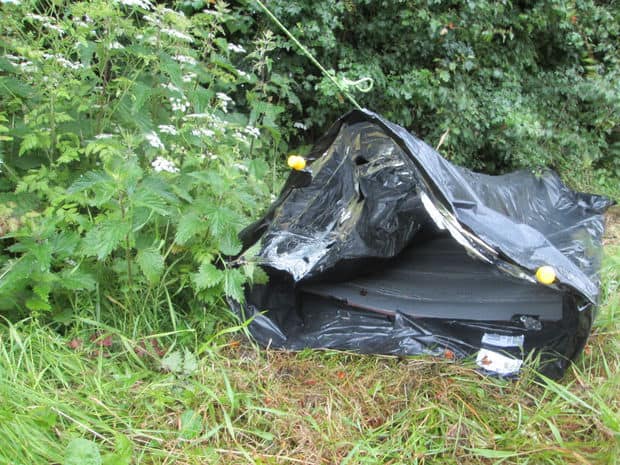
This is a simpler idea which worked:
Tyvek Bivi, Poncho, Tent Floor
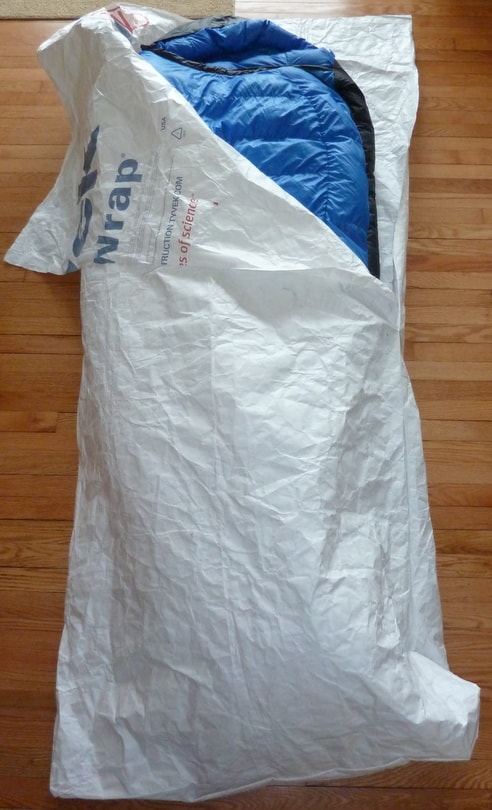
You can also buy one:
Tyvek Sleeping Bag Cover
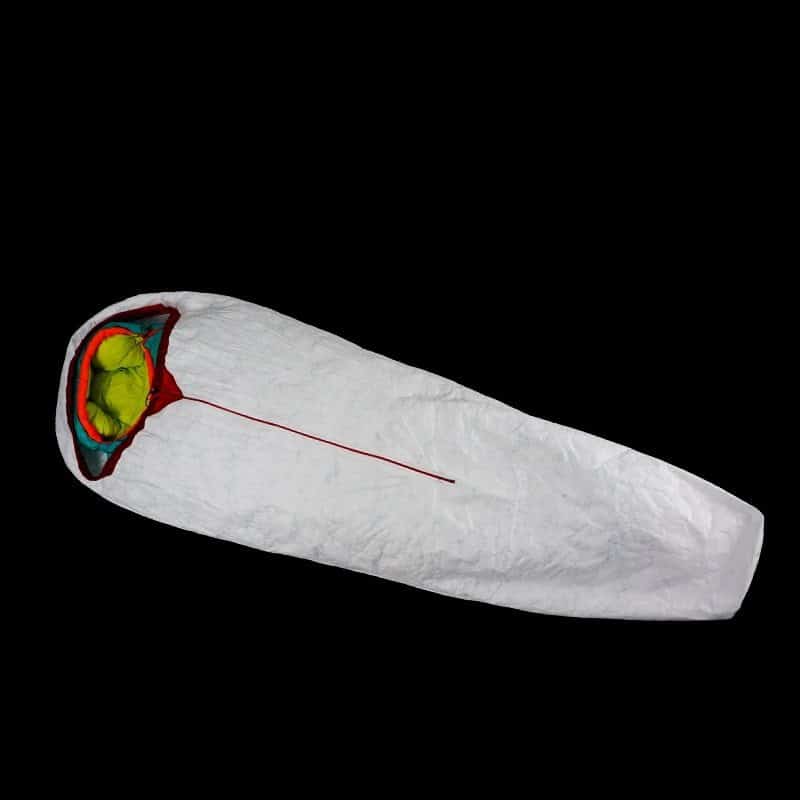
Not DIY, but if you can’t I recommend this very cheap tarp tent (<$50):
Aricxi $30 Tent Review
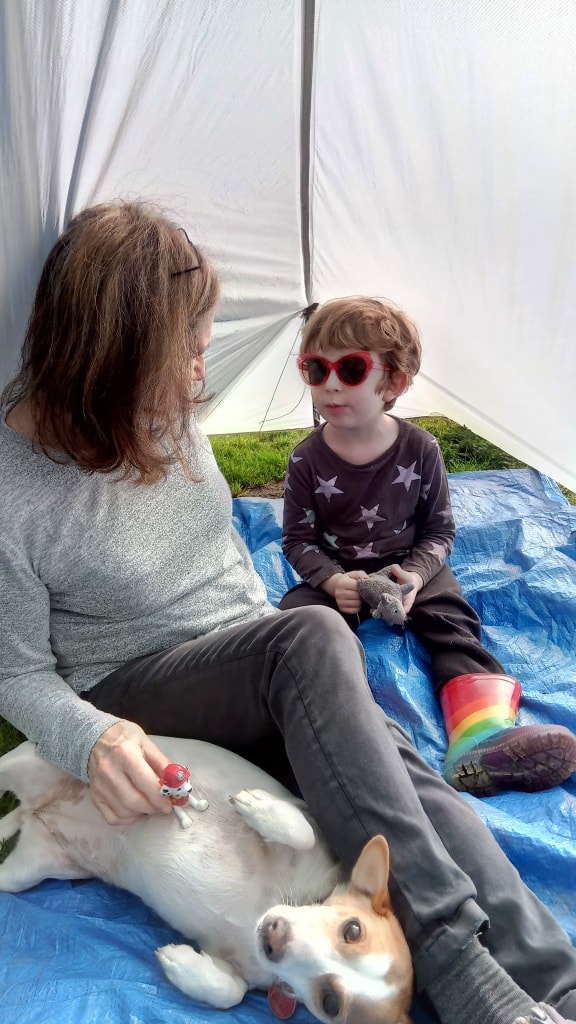
I sometimes think about more permanent DIY shelters too, like this:
Wilderness Hut
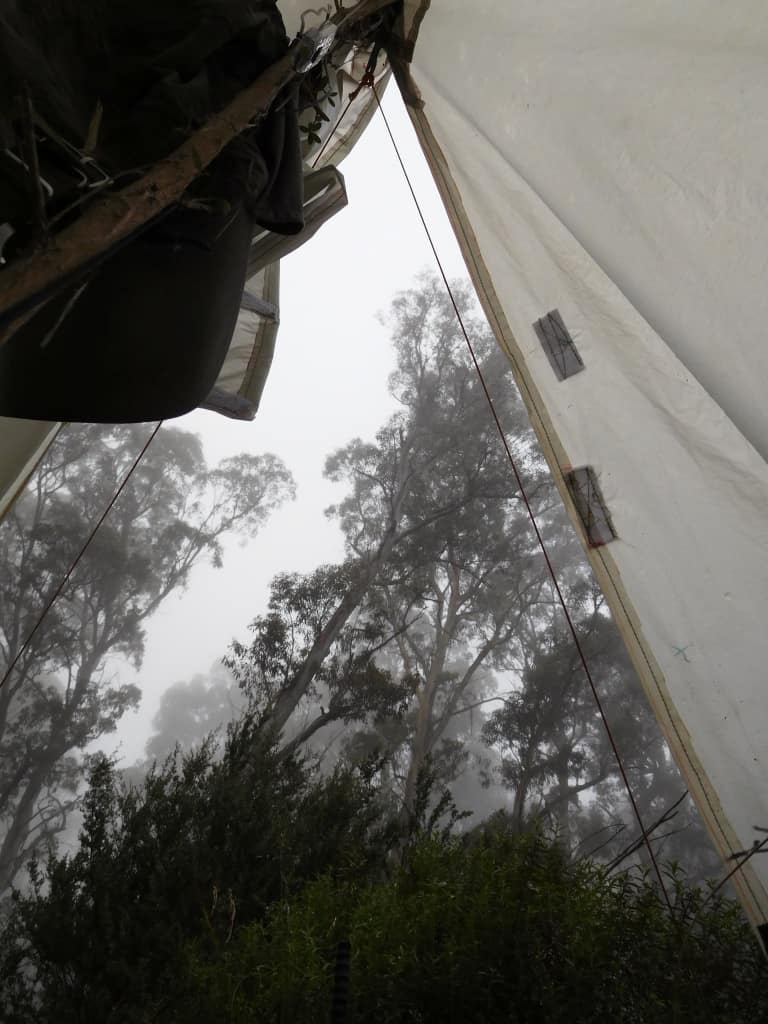
which leads us on to this idea:
The Ultralight Wilderness Hut
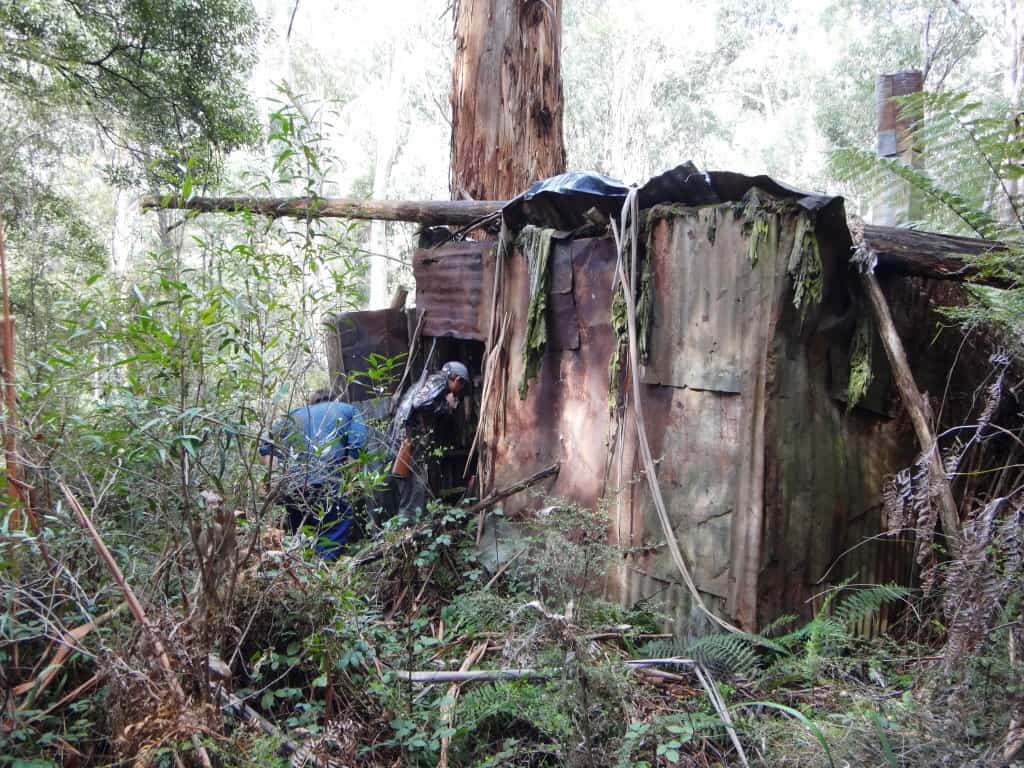
and this:
Debris Hut
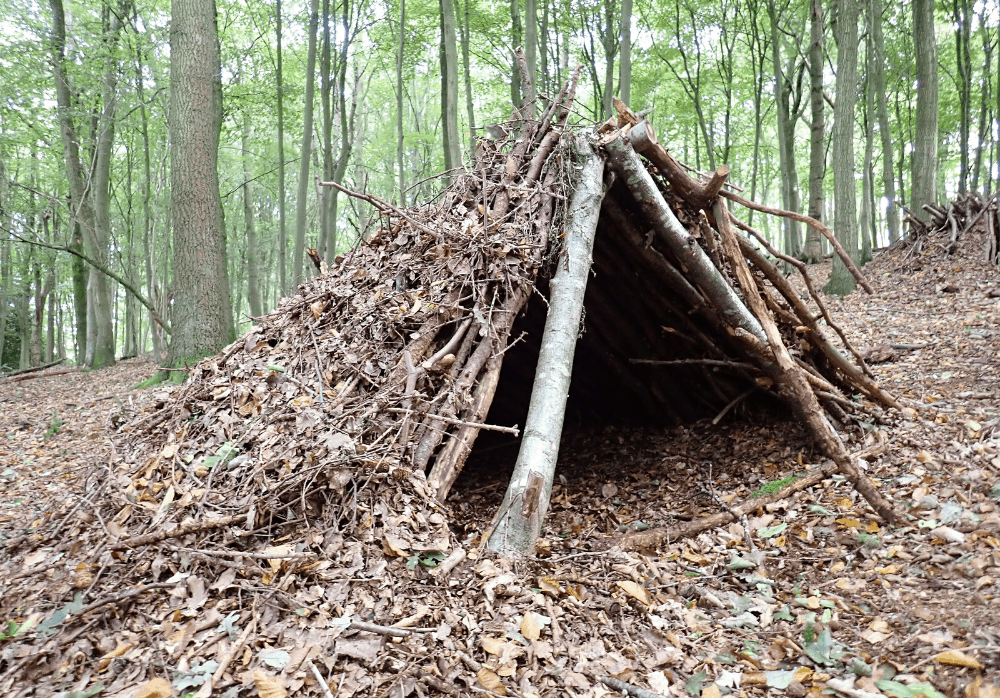
Other tent designs:
Col Townsend Whelen’s Forester Tent
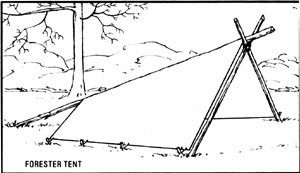
Henry’s Original Tarptent & Tarptent-for-2
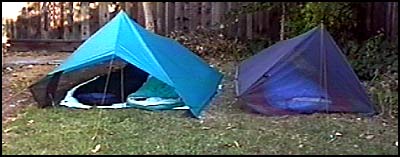
Make Your Own Tarp or Hammock
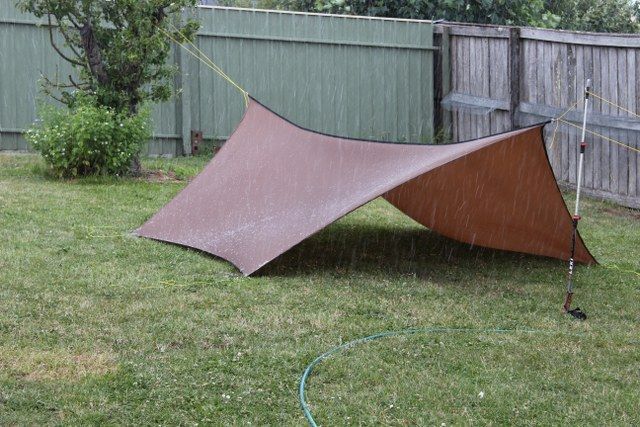
I am working on an ultralight tent stove to warm my shelter:
Tent Stove Progress
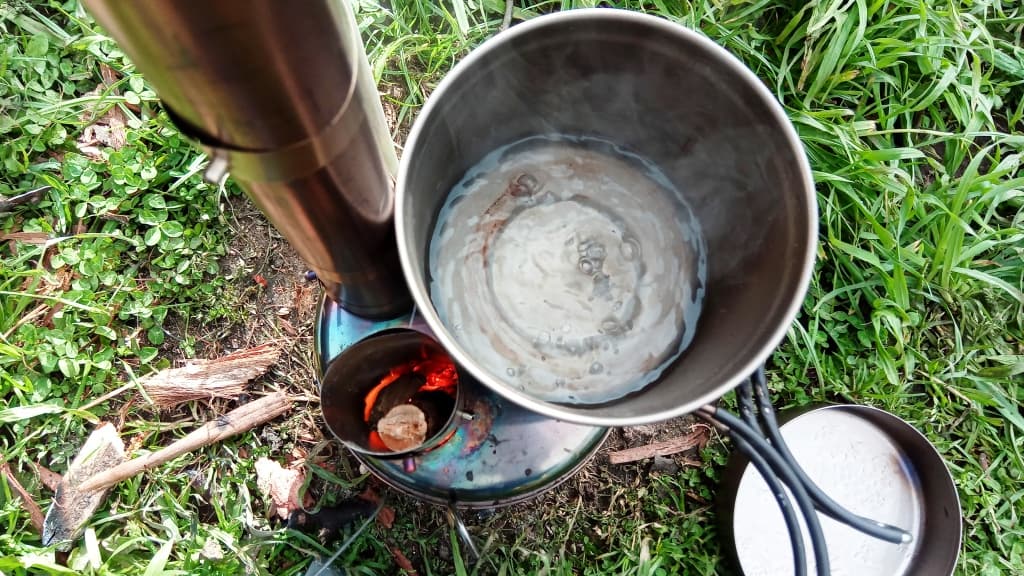
Some newer posts:


Great insights on DIY tent making! I love the idea of customizing my own shelter for ultralight hiking. The tips on material selection and design really sparked my creativity. Can’t wait to try out some of these ideas on my next adventure!
Go for it. And thank you.
Ok, I just have to say…. This is such a pleasant, relaxing website. I came here for the tent diys and stayed for the pure niceness radiating out of every post, not to mention the fact that you have adorable dogs reviewing your craftsmanship each time 😂 Plus the tents are really well done. Stay awesome 👍
Dear Erin, Thank you so much for your lovely comment. It has made my day in quite the reverse way that a (very rare thankfully) quite undeserved negative comment yesterday rather upset me. I am trying just to have a helpful website which I hope will allow people to enjoy the outdoors cheaply and safely. I am working on making a .93 oz/yd2 7 x 7 Multi Tarp right now which I intend to post instructions about. It can be made with just a smidgen over 11′ of fabric at US$7.50/yd. I have already sewn the body of it together and just have to complete the hemming, tie-outs and hood etc. I am also working on a post about a new DIY pack which is quite different to anything out there. Stay tuned. Once again, Thanks. Cheers, Steve.
Wondering if you sew or glue the Tyvek? Love your site.
Thanks for the praise Eric, I sew it but I have also taped the tie-outs, especially the two which take the most stress for extra re-enforcement. This makes sewing difficult though (the needle sticks) so should be done after sewing. Leave a fairly long stitch length for tyvek as it is not a woven material to prevent its wanting to rip along the stitch line. I usually make the tyvek ones as prototypes which I use multiple times to make sure they work before I make a silnylon one, but some I have slept in I guess up to a hundred times without any problems arising. Indeed, The Deer Hunter’s Tent #1 I still have not made a silnylon version of though I am seriously thinking about it at the present. It will gain me a small weight advatage over my Grey Flyer for overnight etc hunting trips mainly by myself. Cheers, Steve.